Physical Address
304 North Cardinal St.
Dorchester Center, MA 02124
Acknowledgments: Josè Adolfo Navarro, MD; Silvia Neri, MD; and Alberto Morabito, MD.
A sound knowledge base of the gastrointestinal (GI) tract embryologic development is important in understanding colon and rectal anatomy and pathophysiology. The primitive gut tube is formed from the endodermal roof of the yolk sac. Early in the development process, beginning in the third week of gestation, the gut tube divides into three sections: the foregut, midgut, and hindgut ( Fig. 52.1 ).
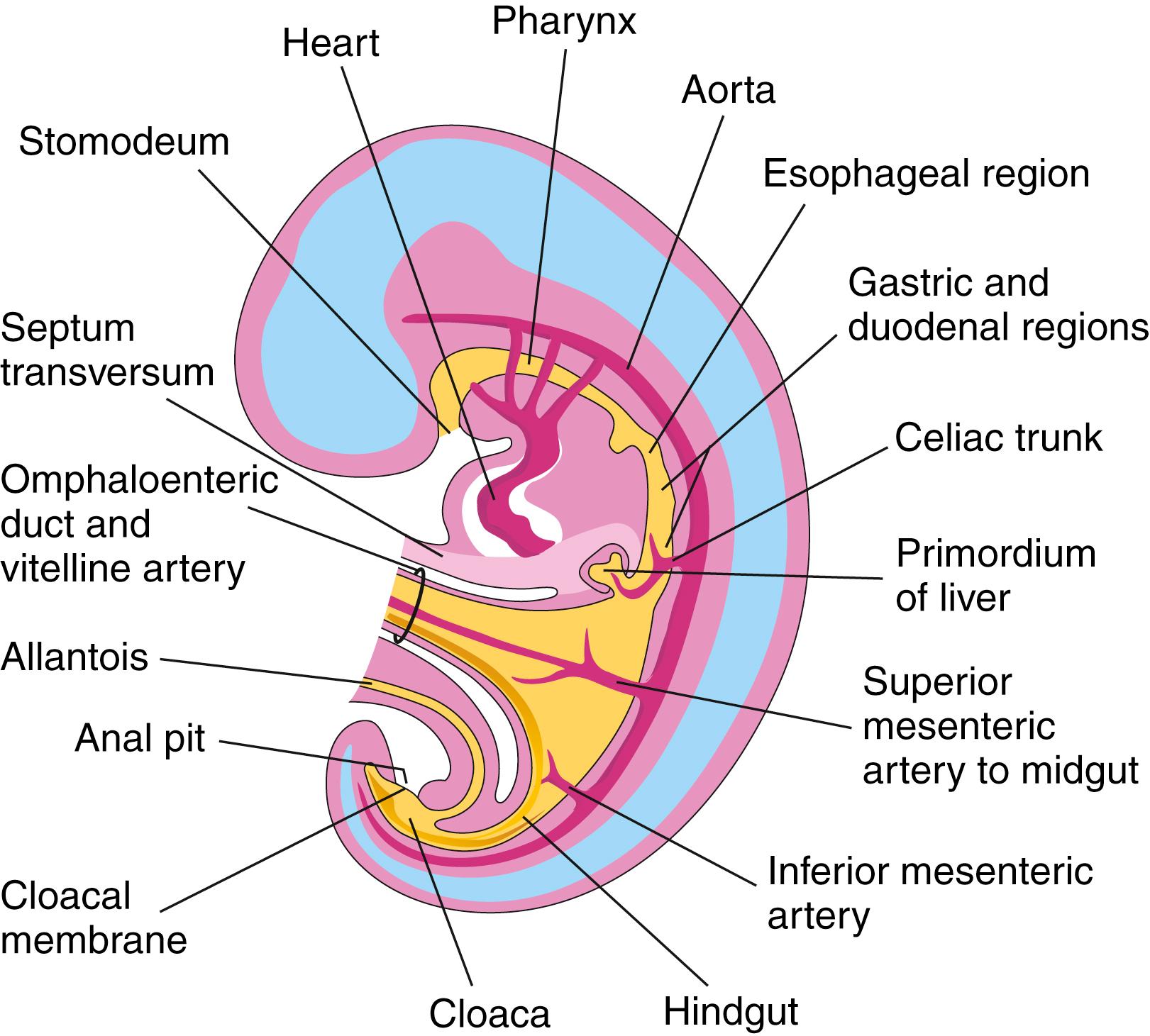
The foregut forms the oral (buccopharyngeal) membrane, esophagus, stomach, and proximal duodenum (to the duodenal ampulla) and is supplied by the celiac artery. The midgut, including the distal part of the duodenum, small intestine, right colon, and the proximal two thirds of the transverse colon, receives it blood supply from the superior mesenteric artery (SMA). The midgut temporarily herniates ventrally out of the abdomen, a key step in the physiologic development progress for acquiring length and correct positioning of its structures ( Fig. 52.2 ). The hindgut develops into the distal third of the transverse colon, descending colon, sigmoid, and rectum all the way to the upper anal canal. It is supplied by the inferior mesenteric artery (IMA). The venous and lymphatic networks develop parallel to their corresponding sectional arteries.
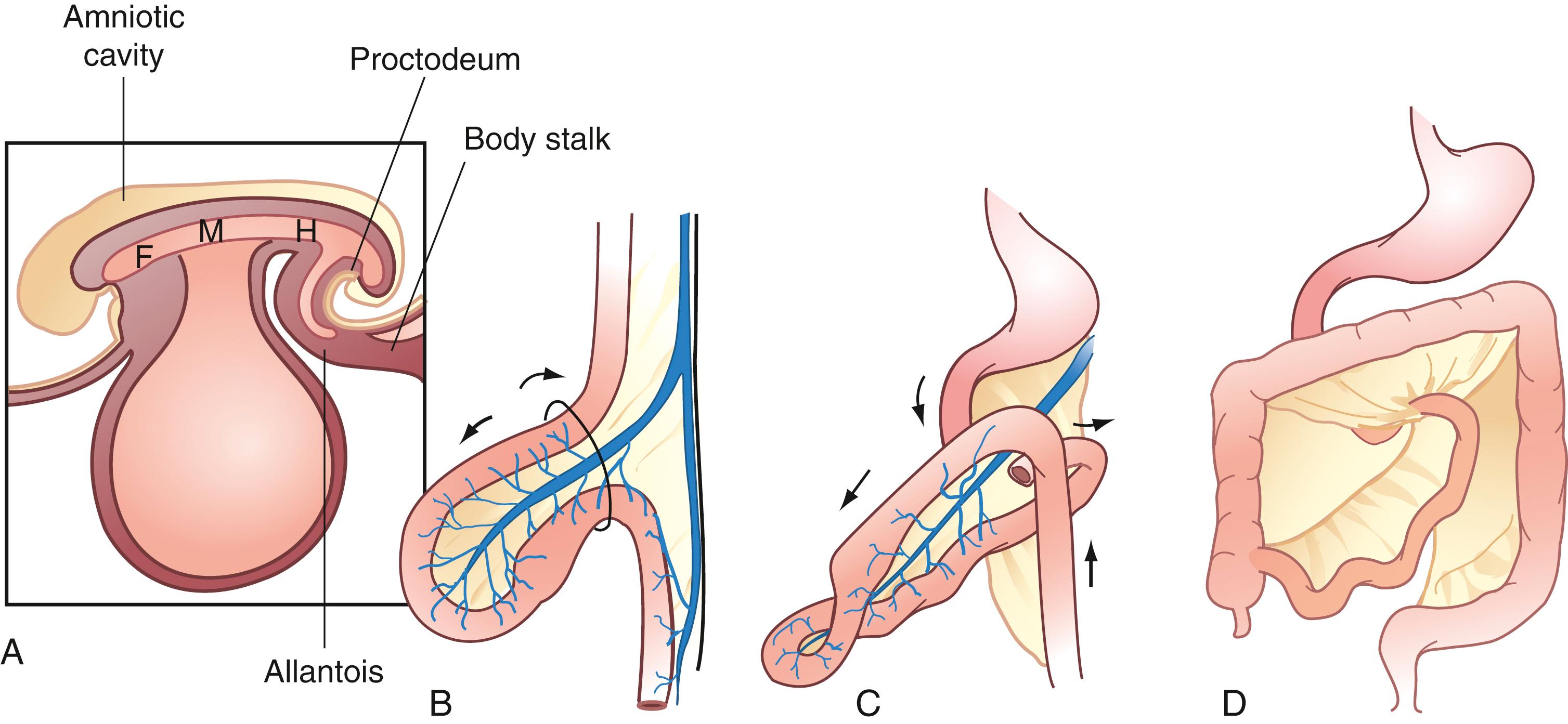
The embryologic development of the rectum is complex and prone to developmental complications (see Chapter 67, Pediatric Surgery ). The proximal rectum develops similar to the colon. The distal regions develop from the terminal hindgut that enters into the cloaca (an endoderm-lined cavity in contact with the surface ectoderm at the cloacal membrane). Prior to 5 weeks, the intestinal and urogenital tracts terminate at a common cavity in the cloaca. During the next few weeks, the urorectal septum migrates caudally and divides the cloaca into an anterior urogenital sinus and posterior distal rectum and anal sinus ( Fig. 52.3 ). The urorectal septum fusion with the cloacal membrane is represented in the adult by the perineal body. The external anal sphincter is formed by the posterior part of the cloacal sphincter, whereas the internal anal sphincter is formed from enlarging circular fibers of the rectum. The upper two thirds of the anal canal are derived from the hindgut and the lower third from the proctodeum. The dentate line marks the fusion of endodermal (hindgut) and ectodermal depression (proctodeum). The anal transition zone is formed from the cloacal part of the anal canal. The hindgut part of the anal canal is supplied by the IMA, while the lower third, by the internal pudendal artery.
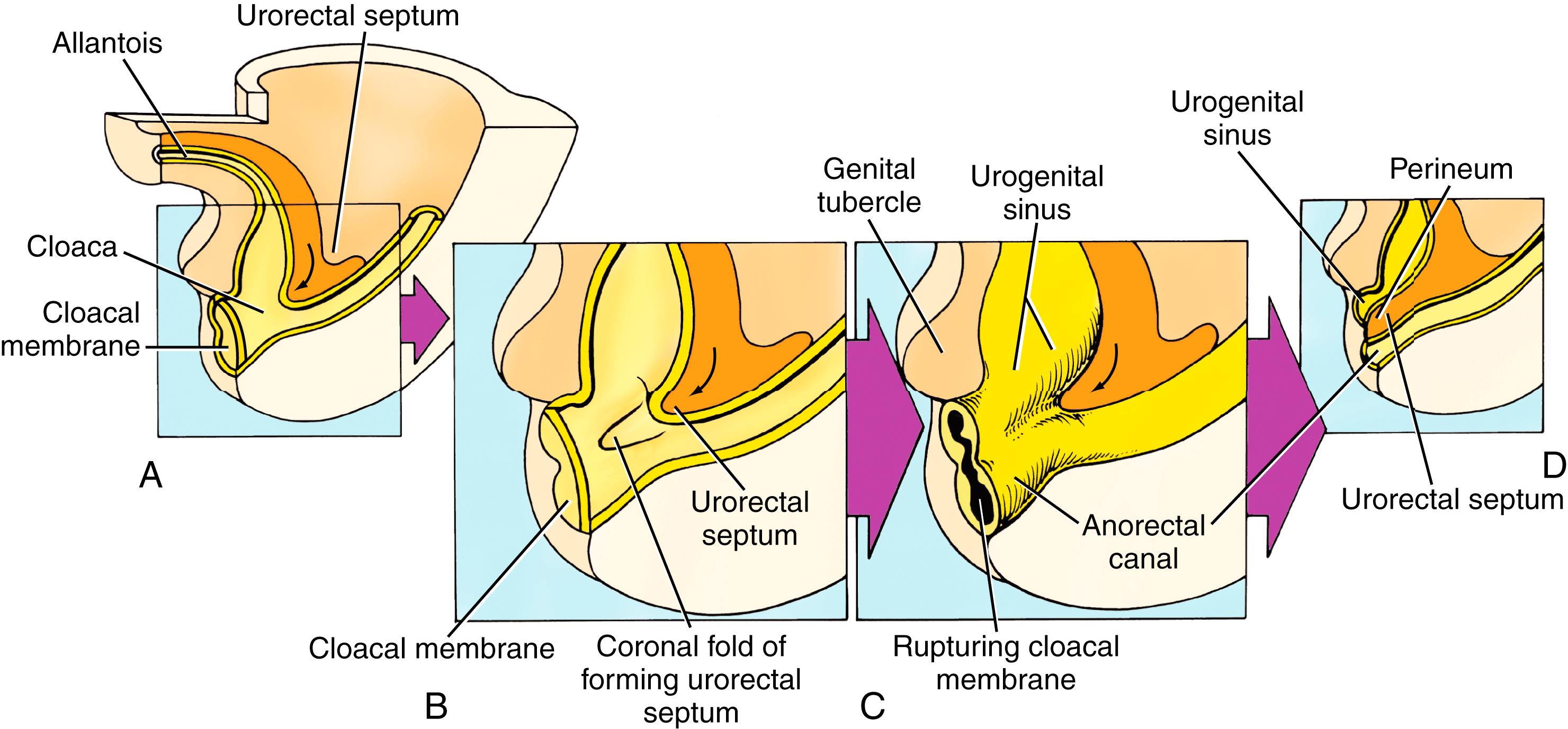
The large bowel including the colon and rectum is a tube of variable diameter, approximately 150 cm in length ( Fig. 52.4 ).

The cecum is the saccular beginning of the colon, with an average diameter of 7.5 cm and a length of 10 cm. It has no mesentery and is completely covered with peritoneum and is therefore considered an intraperitoneal structure. The cecum is variably connected to the posterior abdominal wall by a peritoneal reflection. Patients with an abnormally mobile cecum and ascending colon, found in a small proportion of patients, can be predisposed to volvulus (torsion) or cecal bascule (intermittent anterior and superior folding of the cecum associated with obstructive symptoms). The cecum has a thin wall compared to the rest of the colon, and considering its large diameter, in accordance with the law of Laplace, it is the site most likely to perforate in the presence of large bowel obstructions. Although it is distensible, acute dilation of the cecum to a diameter of more than 12 cm, which can be measured on a plain abdominal radiograph, is associated with risk of ischemic necrosis and perforation of the bowel wall and should be treated promptly, usually with surgery. The terminal ileum empties into the cecum along its medial border through the ileocecal valve, a thickened, nipple-shaped invagination containing circular muscle. In cases of large bowel obstruction, the ileocecal valve is clinically important. An ileocecal valve that does not allow reflux of colonic contents into the ileum (competent ileocecal valve) can result in a closed-loop obstruction, a surgical emergency, whereas a valve that allows retrograde flow into the ileum (incompetent ileocecal valve) will result in less colonic distension and a less acute clinical scenario.
The vermiform appendix extends from the cecum approximately 3 cm below the ileocecal valve as a blind-ending elongated tube, 8 to 10 cm in length ( Fig. 52.5 ). It is most commonly found in a retrocecal position (65%), followed by pelvic (31%), subcecal (2.3%), preileal (1.0%), and retroileal (0.4%) locations. In the setting of inflammation and adhesions, locating the appendix can be difficult. One can reliably reach its base by following the anterior taenia of the cecum to the convergence with the other two taeniae. The bloodless fold of Treves extends from the antimesenteric border of the terminal ileum to the base of the appendix or the anterior surface of the mesoappendix, or to both areas. This fold contains no sizable blood vessels. Since it is the only part of the ileum that has a fold on the antimesenteric side of the bowel, it can help in the recognition of the ileocecal region and the base of the appendix.
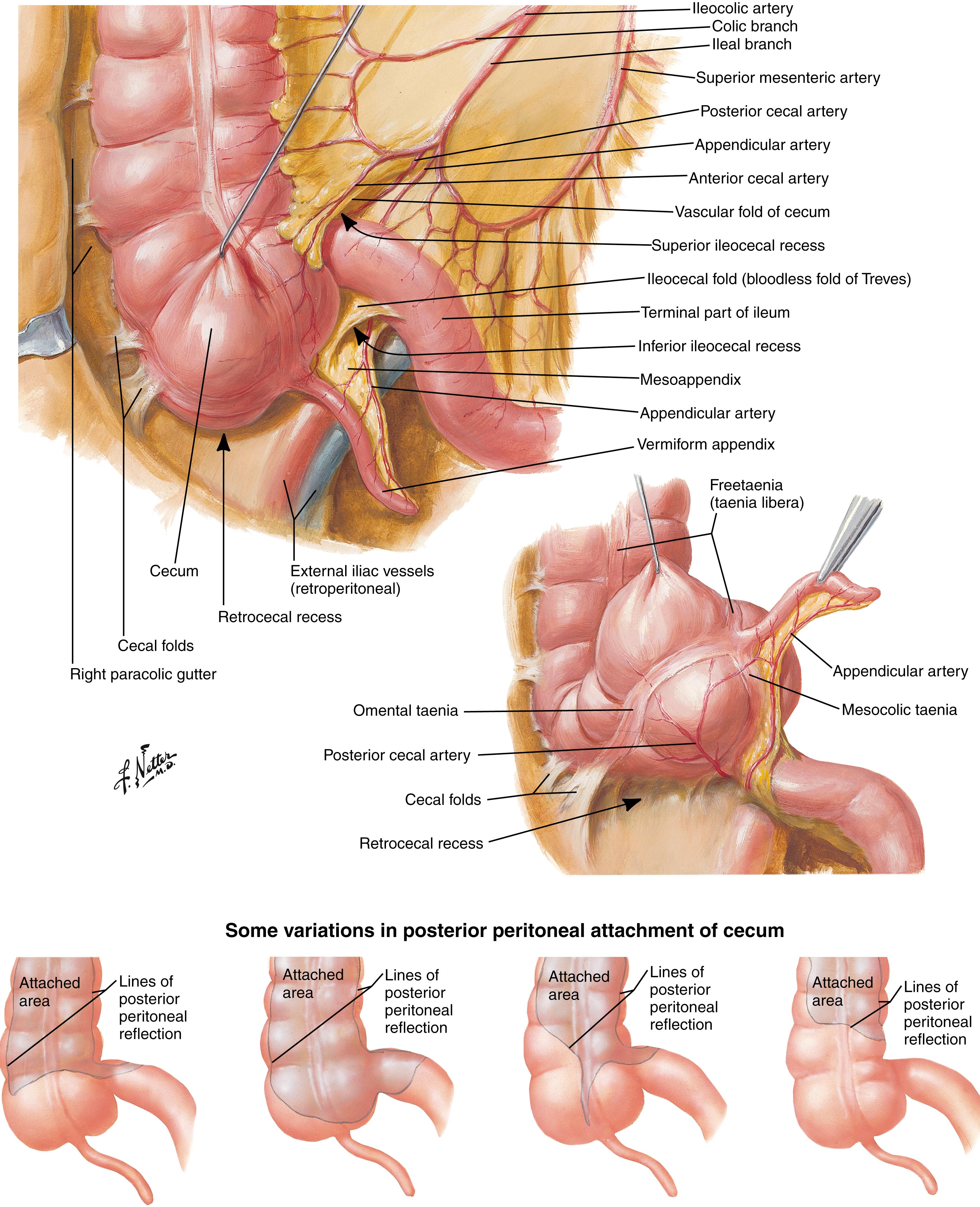
The ascending colon begins at the ileocecal junction and extends upward toward the hepatic flexure on the right side and is approximately 15 cm in length. The anterior and lateral surfaces are covered with peritoneum and are considered intraperitoneal, whereas the posterior surface is fixed against the retroperitoneum by the fascia of Toldt. The ascending colon is best mobilized along the lateral peritoneal reflection by incising the “white line of Toldt,” which represents the fusion of the peritoneum with the posterior fascia of the same name. When releasing the hepatic flexure and lifting the colon medially, one must be aware of the proximity of the second part of the duodenum, which can be inadvertently injured.
The transverse colon, which is approximately 45 cm in length, is suspended between the hepatic and splenic flexures, which are fixed structures. It is completely covered by visceral peritoneum and connected to the posterior abdominal wall by the transverse mesocolon. It has a “U”-shaped curve, which can even reach down to the pelvis in some patients. Recognizing its variability in position is very important when attempting to exteriorize a loop of colon with a “target incision” for a transverse or sigmoid colostomy.
The greater omentum is attached to the superior aspect of the transverse colon. It has two parts, the superior gastrocolic ligament composed of two serous layers, and the inferior portion, which is composed of four serous layers draping over the anterior abdominal cavity like an apron. Its size and volume are highly variable, although in most cases correlated with body weight. Lifting the greater omentum upward with downward traction of the transverse colon will reveal an avascular plane adjacent to the colon most easily identified close to the midline. This plane is useful when separating these two structures. The greater omentum is commonly used to cover the intraperitoneal contents when closing abdominal incisions and also used to fill cavities after surgery helping to control infection. It also provides a good patch, or reinforcement, in cases when closure of inflamed and friable tissues is not possible or likely to fail, such as in the treatment of perforated duodenal ulcer. The omentum can be mobilized to create an omental pedicle that reaches the pelvis, by ligating and detaching either the right- or left-sided omental vessels, achieving extra omental length while the blood supply is adequately maintained by the distal arcade from the other side. Such an omental pedicle can be positioned between the rectum and vagina to buttress a colo- or rectovaginal fistula repair or used to fill the pelvic and perineal spaces after rectal excision.
The splenic flexure, where the transverse colon flexes downward, is found adjacent and inferior to the spleen. It is usually situated higher and deeper than the right colic or hepatic flexure. The splenic flexure is suspended by four mainly avascular ligaments: by the phrenicocolic ligament to the diaphragm, by the splenocolic ligament to the lower pole of the spleen, by the renocolic ligament to the Gerota fascia, which surrounds the left kidney, and by the pancreaticocolic ligament to the tail of the pancreas. The splenic flexure can be released or mobilized without dividing any major blood vessels if one is separating the correct plane ( Fig. 52.6 ). Surgeons commonly dissect the descending colon along the line of Toldt from below and then enter the lesser sac by lifting the omentum above the transverse colon. This maneuver allows mobilization of the flexure to be achieved, with minimal traction. Bleeding is most commonly encountered from excessive downward traction resulting in avulsion of a portion of the splenic capsule.
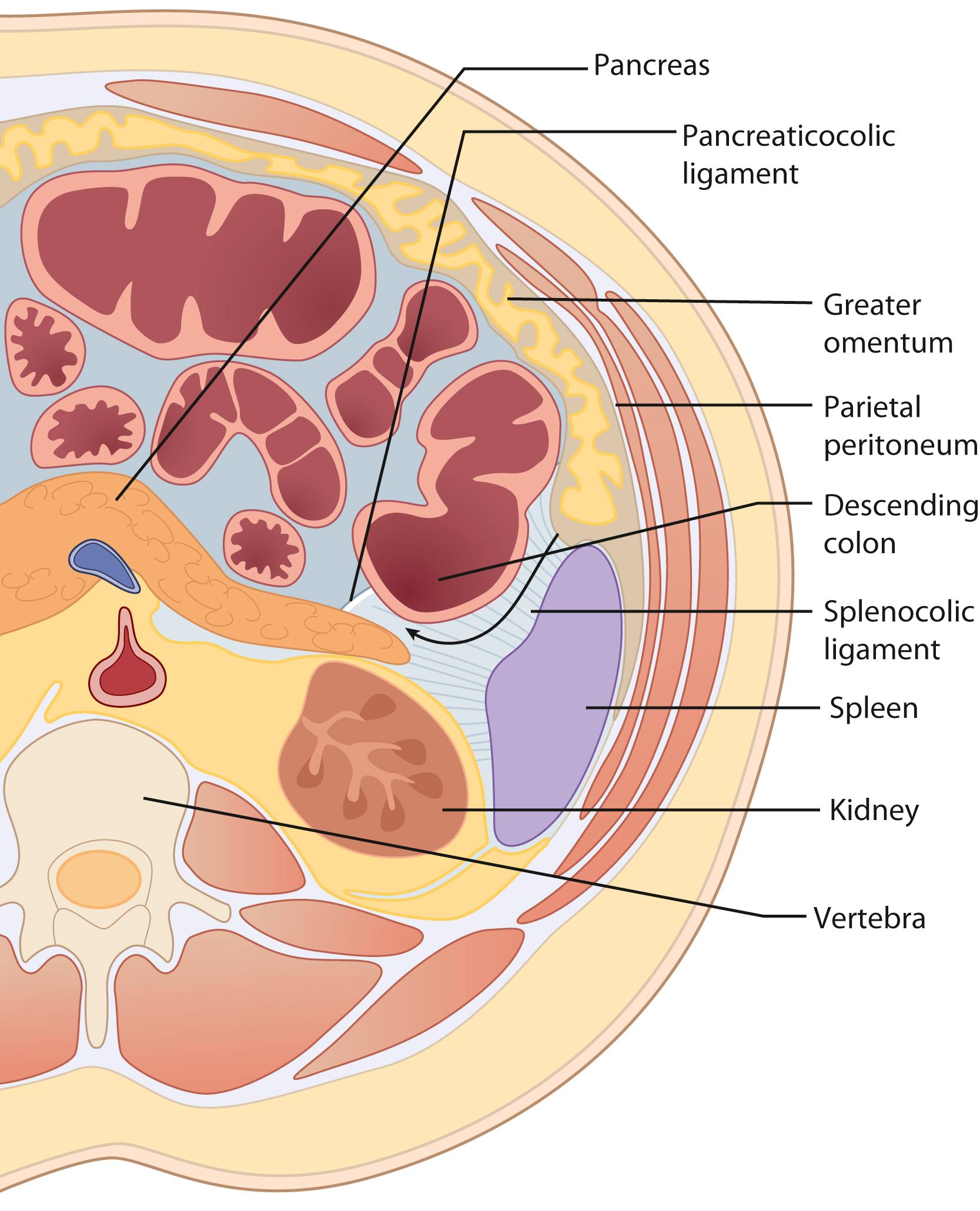
The descending colon begins at the splenic flexure where the intestine loses its mesentery and extends downward on the left side of the abdomen approximately 25 cm until it transitions into the sigmoid colon. It is smaller in diameter than the ascending colon. The descending colon is similar to the ascending colon with regard to its peritoneal coverage and approach to dissection.
The sigmoid colon begins at or below the level of the iliac crest, where the colon becomes completely intraperitoneal again, acquiring a mesentery covered on both sides with peritoneum. The sigmoid is thicker and more mobile compared to the descending colon varying in length from 15 to 50 cm (average, 38 cm). The mobile portion of the sigmoid colon is attached by the sigmoid mesocolon to the posterior abdominal wall and pelvis in the pattern of an inverted V creating the intersigmoid fossa ( Fig. 52.7 ). When mobilizing the sigmoid colon, this mesenteric fold is a surgical landmark for the underlying left ureter. The sigmoid colon ends at the rectosigmoid junction, which is recognized as the point where the colonic taeniae confluence to form a complete longitudinal muscle layer, and the colon loses its mesentery, usually between the level of the sacral promontory and the S3 vertebra.
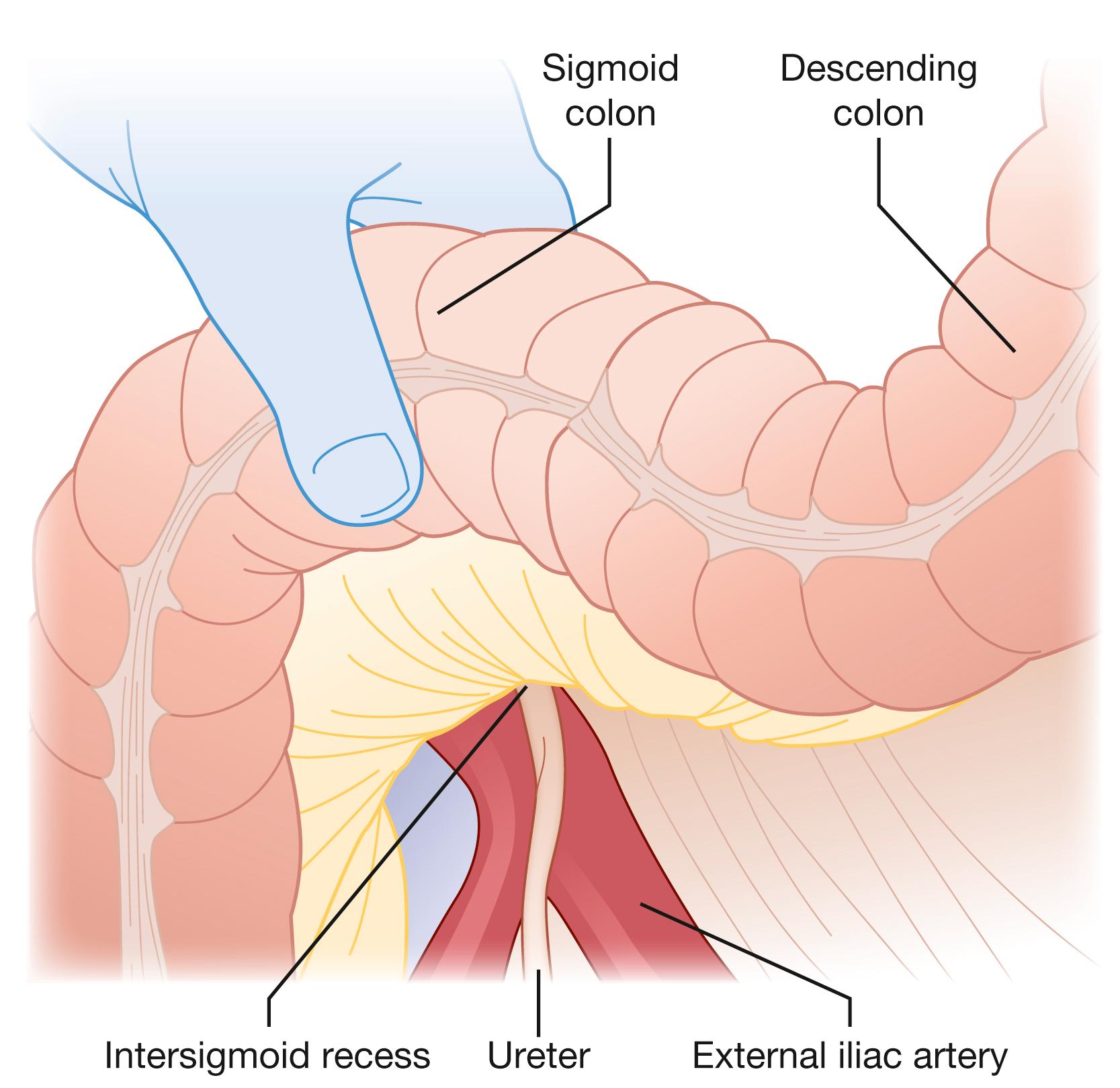
The anatomy of the blood supply is in accordance with the embryologic development of the GI tract. The celiac artery supplies the foregut, the SMA the midgut, and the IMA the hindgut. The colon receives its blood supply from the SMA and the IMA, both anterior branches of the abdominal aorta ( Fig. 52.8 ).
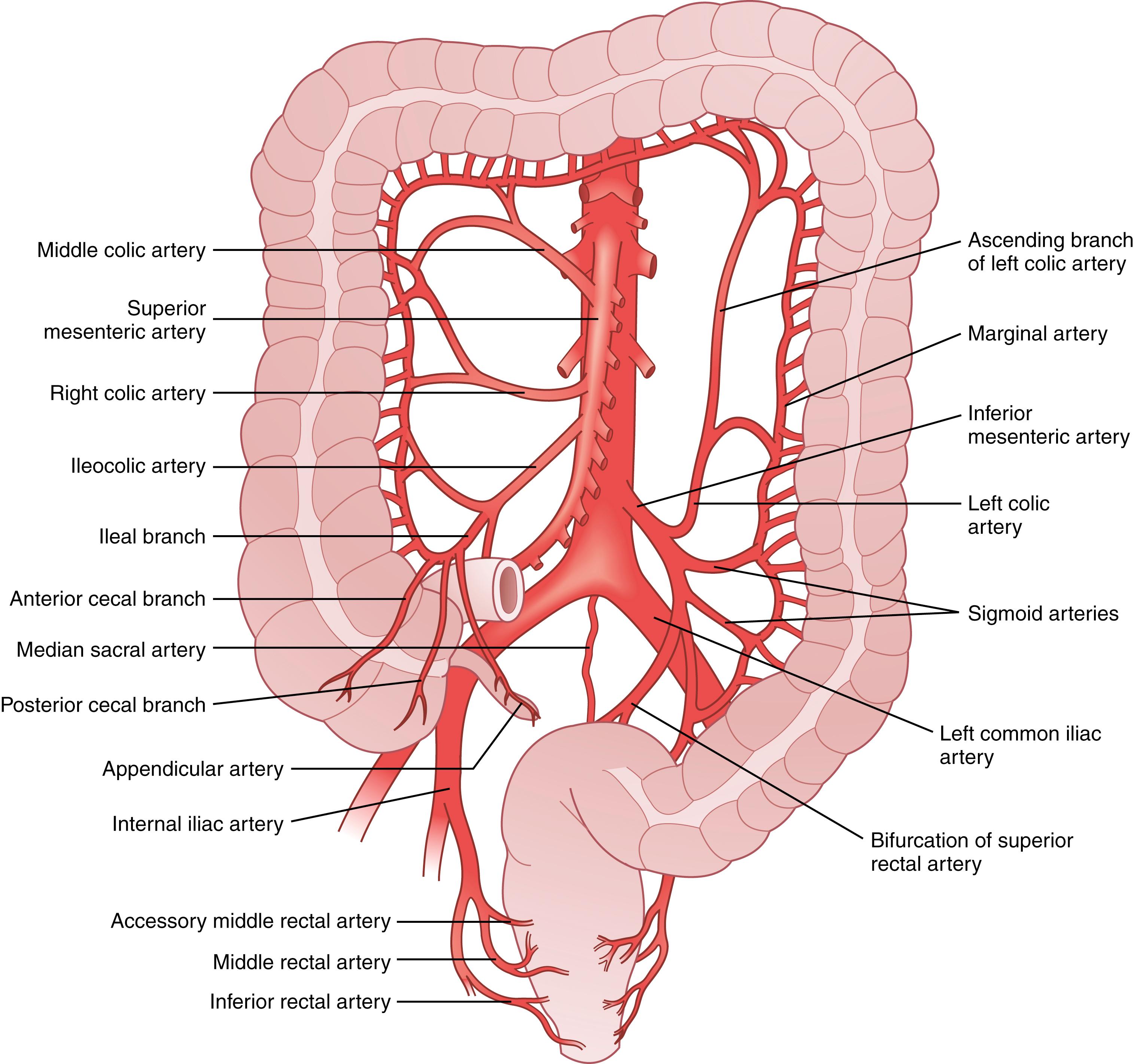
The SMA is the second unpaired anterior branch of the aorta, arising at the level of the lower border of the L1 vertebra, it descends posterior to the pancreas and then crosses anteriorly to the uncinate process of the pancreas and the third part of the duodenum and enters the mesentery of the bowel. On the left side, it provides up to 20 branches to the small intestine. On the right, it gives off three major branches to the colon. The first branch is the middle colic artery, arising near the inferior border of the pancreas, followed by the right colic and ileocolic arteries. The ileocolic artery is the most constant of these arteries. It runs toward the ileocecal junction within the mesentery giving off the anterior and posterior cecal arteries and the appendicular artery, supplying the terminal ileum, cecum, and appendix. The avascular space between the SMA and the ileocolic artery is a safe region to begin vascular dissection in a minimally invasive right colectomy and can also be used as a space through which one can pull the transverse or right colon through in cases of “retroileal” colorectal anastomoses to gain bowel length. The right colic artery, absent in up to 20%, usually arises from the SMA but may be a branch of the ileocolic or left colic vessels. The middle colic artery enters the transverse mesocolon and divides into right and left branches, which supply the proximal and distal transverse colon, respectively. When lifting the transverse colon, the middle colic artery can be tracked to the base of the mesentery just to the right of the ligament of Treitz, and into the proximal SMA. The middle colic artery is the main blood supply to the splenic flexure in about a third of the cases.
The IMA is the third unpaired anterior artery arising from the aorta at the level of the L2–3 vertebrae approximately 3 cm above the aortic bifurcation. The IMA descends inferiorly and to the left giving off the left colic artery, followed by several sigmoid branches, and culminating in the superior rectal (hemorrhoidal) artery. The left colic artery divides into an ascending branch to the splenic flexure and a descending branch to the descending colon.
The marginal artery of Drummond runs along the mesenteric margin of the colon from the cecocolic junction to the rectosigmoid junction. Vasa recta from this artery branch off at short intervals and supply the bowel wall directly. The marginal artery is important clinically for when one of the larger arteries is obstructed (emboli, atherosclerosis, surgical ligation, etc.). The colon can receive collateral blood supply through this artery.
The meandering mesenteric artery, or “arc of Riolan,” is an uncommon finding described as a thick tortuous collateral vessel that runs close to the base of the mesentery and connects the SMA or middle colic artery to the IMA or left colic artery. It can have an important role in blood delivery in cases of SMA or IMA occlusion. Flow can be forward (IMA stenosis) or retrograde (SMA stenosis), depending on the site of obstruction. The presence of a large arc of Riolan suggests occlusion of one of the major mesenteric arteries.
Venous drainage somewhat follows the arterial supply through the superior mesenteric and inferior mesenteric veins (IMVs), which contribute to the formation of the portal vein. It is important to note that the IMV continues beyond the IMA along the base of the mesentery to the left of the ligament of Treitz and into the portal vein ( Fig. 52.9 ). The IMV can be divided to achieve extra colonic length for low pelvic anastomoses.
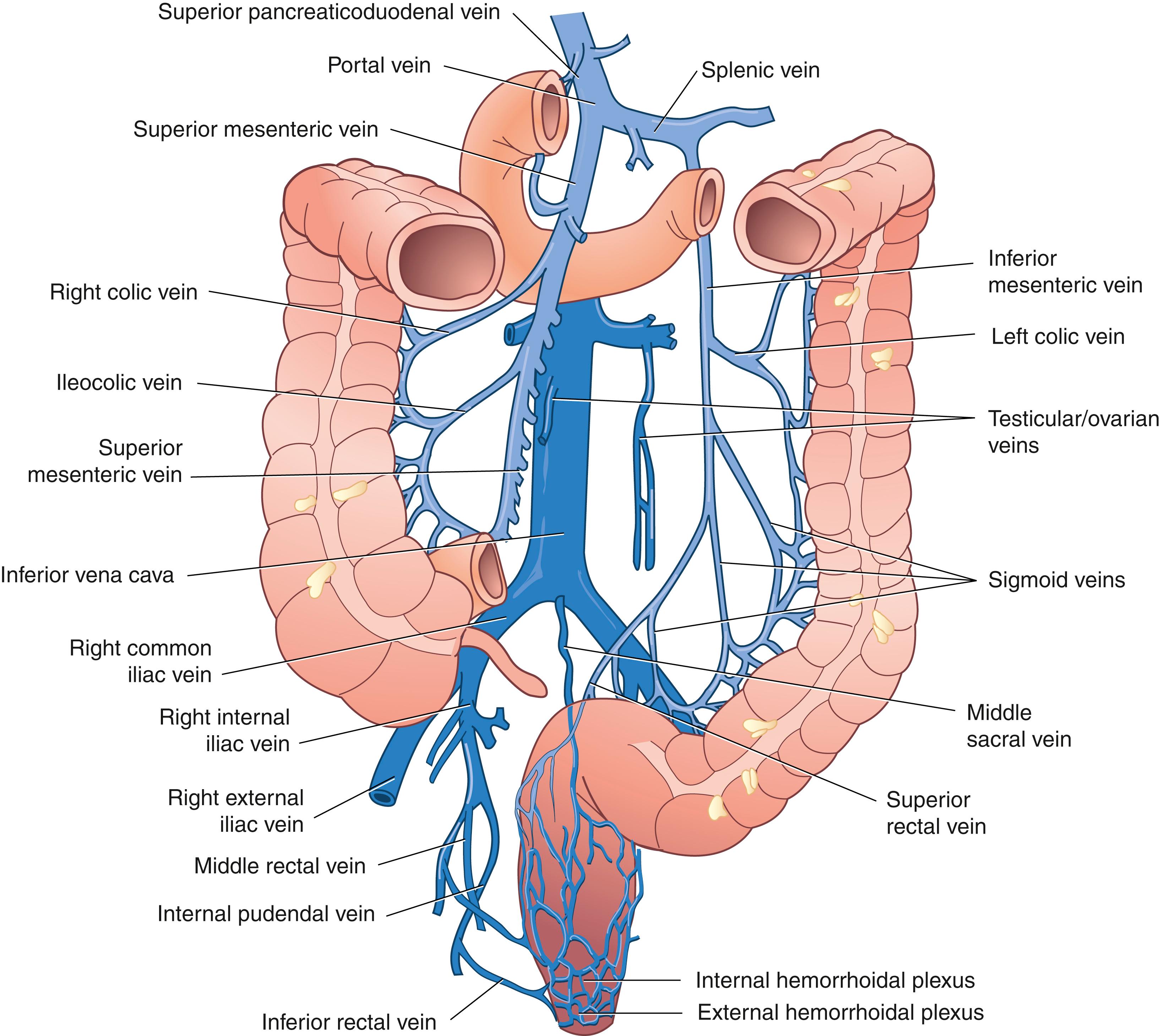
Lymphatic drainage generally follows the vascular supply. The wall of the large bowel is supplied with a rich network of lymphatic capillaries that drain to groups of lymph nodes paralleling the arterial supply. Most of the lymphatic drainage goes in this direction, but communications are found between groups of lymph nodes, especially at the level of the paracolic groups at the level of the marginal arteries. There is also some dual drainage from the distal transverse and splenic flexure into both the superior and inferior mesenteric lymph nodes.
The innervation of the large intestine has both sympathetic and parasympathetic components, which generally follow the blood supply.
The rectum begins at the rectosigmoid junction and ends at the level of the anus. Anatomists define the distal border as the dentate (pectinate) line based on the mucosal surface, whereas surgeons define it as the proximal border of the anal sphincter complex at the level of the levator ani (about 2 cm above the dentate line). The rectum with a total length of around 15 to 20 cm is divided into thirds based on its peritoneal relationships. The upper rectum is covered by peritoneum anteriorly and laterally and its lower limit extends to approximately 10 cm above the dentate line. The middle third is covered by peritoneum only anteriorly and extends from 5 to 10 cm above the dentate line. The lower third of the rectum is totally extraperitoneal, extending from 1 to 5 cm above the dentate line. The rectum has three lateral curves or valves of Houston, the proximal and distal valves fold to the right and the middle to the left. They are lost after full surgical mobilization of the rectum, providing approximately 5 cm of additional length assisting the surgeon’s ability to fashion an anastomosis deep in the pelvis. Structurally, the rectum lacks taeniae coli, epiploic appendices, and haustra. The anterior peritoneal reflection between the rectum and anterior structures, the rectovesicular pouch in males and rectouterine or Douglas pouch in females, is 7 to 9 cm from the anal verge in men and 5 to 7.5 cm in women ( Fig. 52.10 ). The anterior peritoneal reflection is the lowest dependent part of the peritoneal cavity. It is clinically important as a common location of fluid and pus accumulation and may serve as a site of peritoneal metastases from visceral tumors. These “drop” metastases can form a mass in the cul-de-sac (Blumer shelf) that can be recognized on digital rectal examination. “Mesorectum” refers to the visceral mesentery of the rectum. Recognition of mesorectal planes during rectal surgery is extremely important as it allows for a relatively bloodless dissection with consistent excision of relevant lymphatic tissues, adhering to the basic surgical oncologic principle of removing the cancer in continuity with its blood and lymphatic supply. Total mesorectal excision (TME), based on a detailed understanding of anatomy, has been shown to reduce the incidence of local recurrence of rectal cancer and increase the preservation of urinary and sexual function. The mesorectum is relatively thick posteriorly, thinner along the sides, and very thin anteriorly.
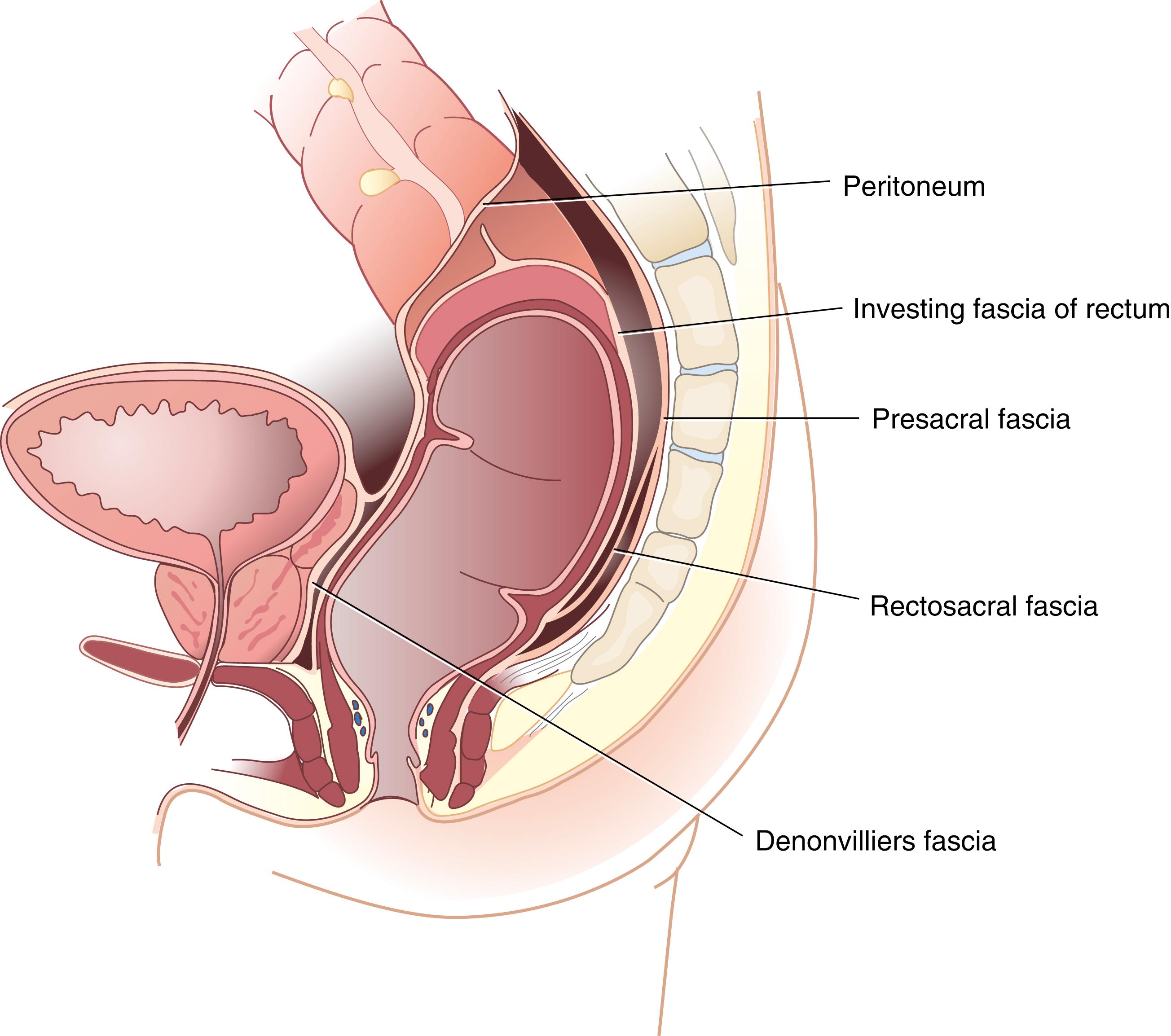
Anatomic structures adjacent to the rectum are clinically important with regard to dissection planes and to direct extension of tumors and/or fistulas. In males, the rectum is adjacent anteriorly and extraperitoneally to the urinary bladder, ureters, vas deferens, seminal vesicles, and prostate. In women, intraperitoneally, it is adjacent to the uterus, tubes, ovaries, and to the upper part of the posterior vaginal wall. Extraperitoneally, the rectum is adjacent to the uterine cervix and posterior vaginal wall. In both genders, the intraperitoneal cul-de-sac is commonly filled with small bowel and colon. The sacrum, sacral vessels, and sacral nerve roots are located posterior to the rectum.
The posterior aspect of the rectum is invested with a thick, closely applied mesorectum ( Fig. 52.11 ). A thin layer of investing fascia (fascia propria) coats the mesorectum and represents a distinct layer from the presacral fascia against which it lies. During proctectomy for rectal cancer, mobilization and dissection of the rectum proceed between the presacral fascia and fascia propria. The presacral fascia covers the anterior sacrum and coccyx. A group of veins, on the presacral periosteum, the presacral veins, drain into the sacral foramina. Dissection deep to the presacral fascia can cause severe bleeding from the underlying presacral venous plexus. Such bleeding can be very difficult to control, as the torn vessels tend to withdraw into the sacral foramina. The rectosacral fascia, or Waldeyer fascia, is a thick condensation of endopelvic fascia connecting the presacral fascia to the fascia propria at the level of S4 that extends to the posterior-inferior rectum. Dividing Waldeyer fascia during dissection from an abdominal approach provides access to the deep retrorectal pelvis. Laterally, the rectum is connected to the pelvic sidewall by the “lateral stalks” or ligaments. These are found in the low pelvis at the level of the prostate or mid-vagina. It is important to remember that in about a quarter of the cases, a branch of the middle rectal artery traverses them and may cause bleeding when cutting through them. Denonvilliers fascia, located anterior to the rectum, is a membranous layer that is an extension of the inferior peritoneal reflection and extends to the perineal body. This fascial layer separates the rectum from the previously mentioned anterior structures and is considered as the anterior border of a TME.
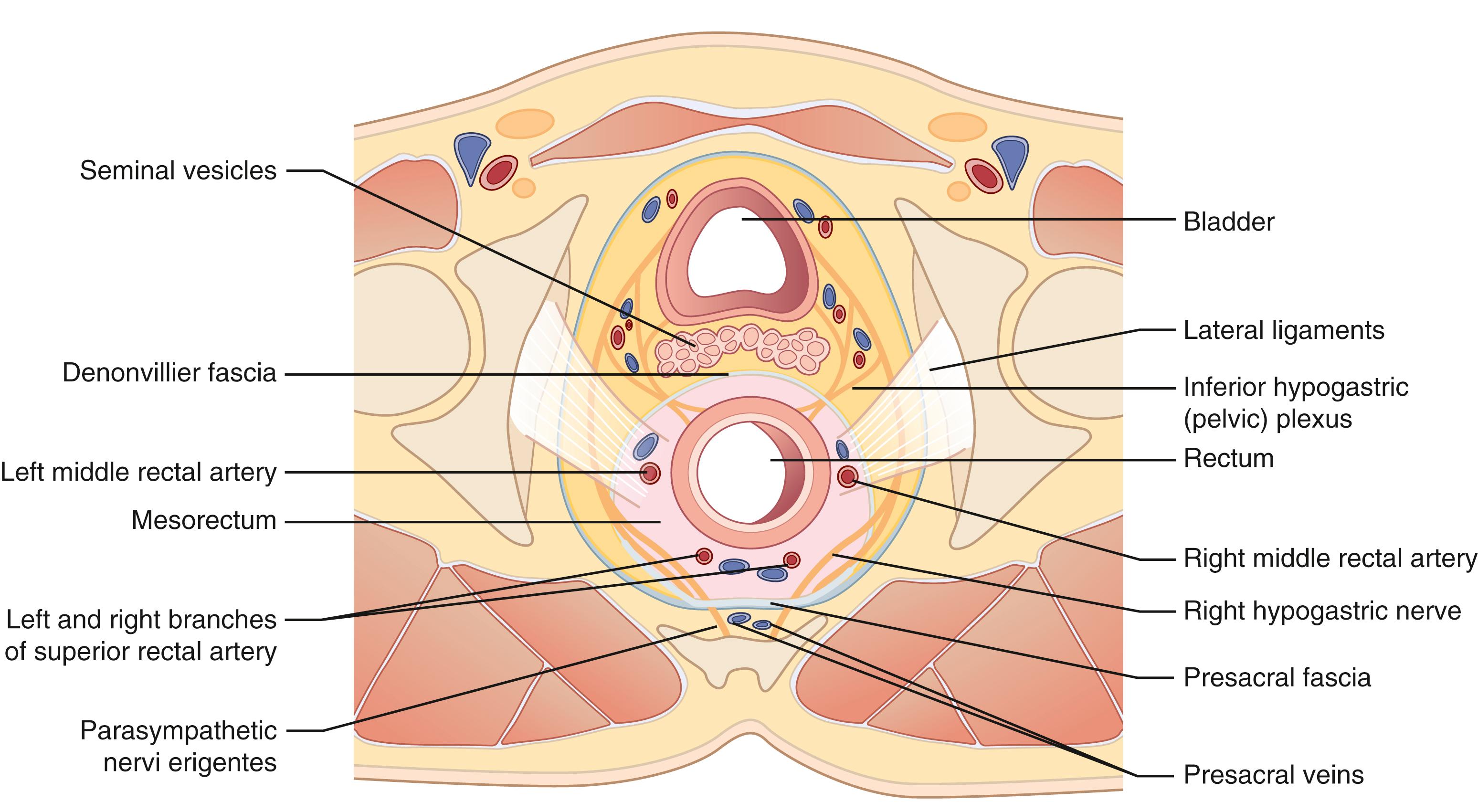
The blood supply to the rectum is derived from the superior, middle, and inferior rectal (hemorrhoidal) arteries. All three rectal arteries are connected with a strong anastomotic network, which helps avoid rectal ischemia after dividing the superior rectal arteries during anterior resections ( Fig. 52.12 ). The superior rectal artery is the end branch of the IMA. It usually divides into left and right branches that run posteriorly downward. The middle rectal arteries are paired vessels derived from the internal iliac arteries to the lower rectum through the lateral columns. They are not considered a major blood supply to the rectum and are found inconstantly. They can be inadvertently injured when dissecting the lateral ligaments. The inferior rectal arteries are branches of the internal pudendal arteries and generally supply the anus distal to the dentate line.
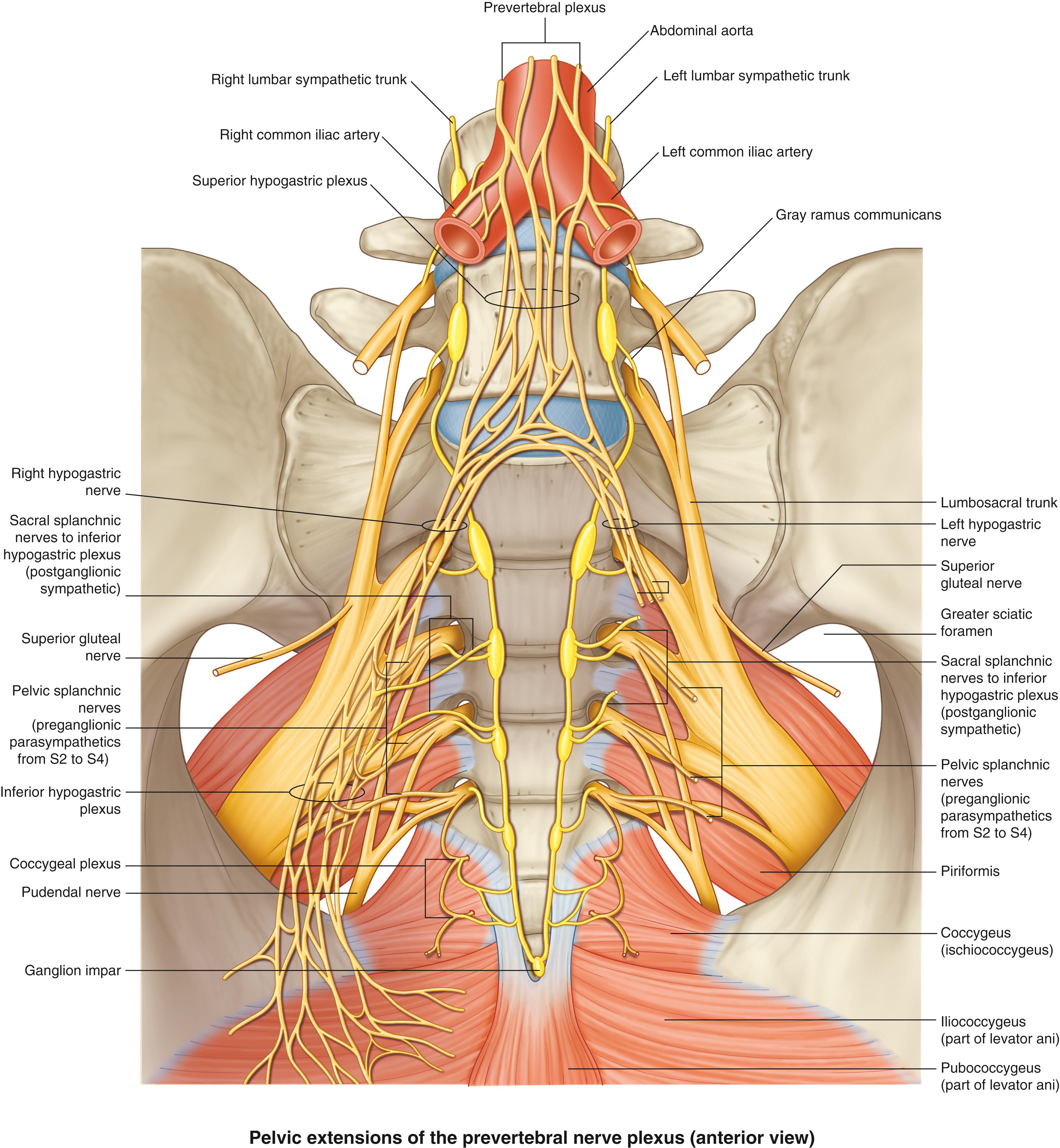
The superior rectal vein drains the upper two thirds of the rectum, draining into the IMV and portal system. The lower rectum and anus drain into the middle and inferior rectal veins, which are connected to the internal iliac and systemic circulation. This drainage pattern explains the higher rate of lung metastases observed with low rectal cancers as compared to mid and upper rectal cancers, which are much more likely to metastasize to the liver.
The lymph from the upper two thirds of the rectum drains upward toward the inferior mesenteric and paraaortic nodes. The lower part of the rectum drains in two directions, cephalad toward the inferior mesenteric nodes and laterally and inferiorly toward the internal iliac nodes. Below the dentate line, lymph drains toward the inguinal lymph nodes.
The sympathetic innervation of the rectum is derived from sympathetic nerves exiting at the level of L1–3, forming the superior hypogastric plexus ( Fig. 52.13 ). At the level of the sacral promontory, they divide into left and right hypogastric nerves, traveling on both sides of the pelvis. These nerves supply the rectum and send branches to supply the genitourinary system anteriorly. When performing pelvic operations, it is important to be aware of these nerves and avoid injuring them if possible. A high IMA ligation injuring the superior hypogastric plexus or severing the hypogastric nerves near the sacral promontory may result in sympathetic dysfunction characterized by retrograde ejaculation in men. Division of the lateral stalks too close to the pelvic sidewall may injure the pelvic plexus and nervi erigentes and cause erectile dysfunction, impotence, and atonic bladder. Injury to the periprostatic plexus when dissecting anteriorly can also cause sexual and bladder dysfunction.
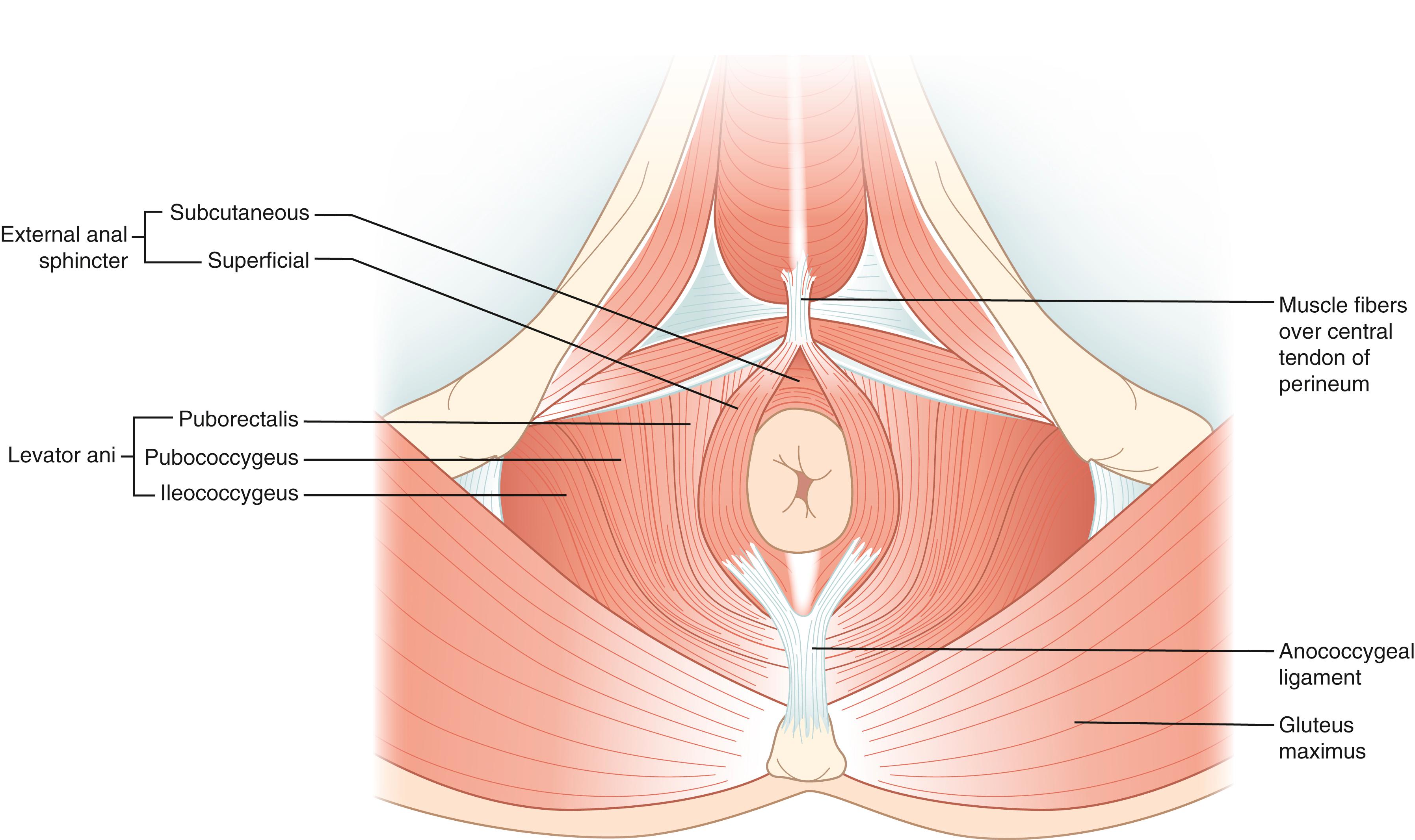
The pelvic floor or diaphragm supports the pelvic organs and, together with the anal sphincter, regulates defecation. The pelvic diaphragm resides between the sacrum, obturator fascia, ischial spines, and pubis. The levator ani muscle, which makes up the floor, consists of three subdivisions: the pubococcygeus, iliococcygeus, and the puborectalis ( Fig. 52.14 ). The pubococcygeus forms the levator hiatus, which ellipses the top of the anal canal, urethra, and vagina in women and the dorsal vein in men. The puborectalis originates in the lower part of the symphysis pubis and courses parallel to the anorectal junction, forming a U-shaped sling of striated muscle posterior to the rectum. The puborectalis is in a state of constant contraction, increasing the anorectal angle, a factor critical to the maintenance of fecal continence. Relaxation of the puborectalis straightens the anorectal angle and permits defecation. Puborectalis dysfunction is an important cause of defecation disorders.
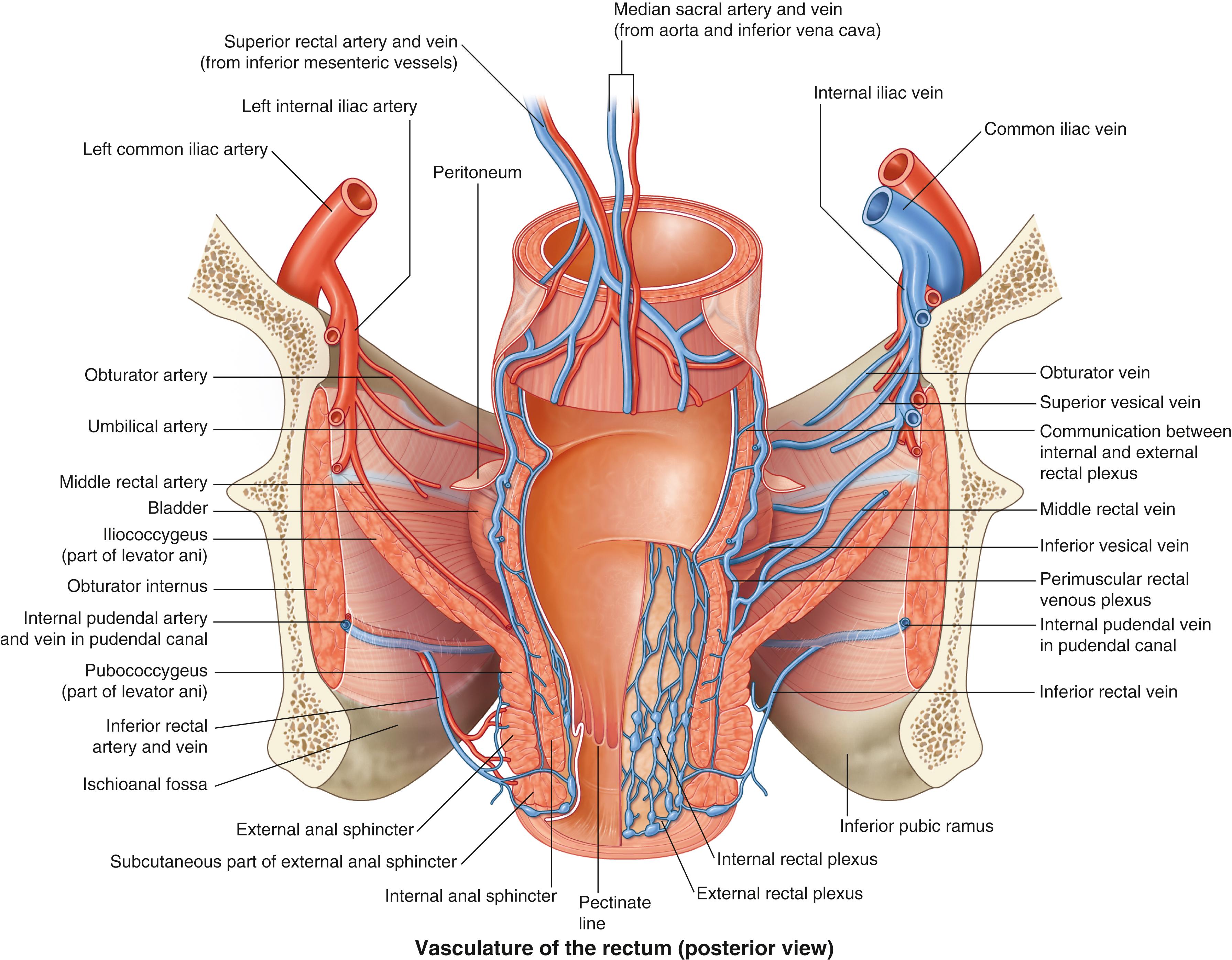
The major functions of the colon are water absorption and electrolyte exchange. This process converts succus from the terminal ileus into formed stool that is stored in the rectal reservoir until it can be excreted at a convenient time. The body has the ability to adapt and sustain life without a colon, making it uniquely different to small bowel. The problems associated with colonic patients provide a simplistic view of colonic function—individuals with a diverting ileostomy are at particular risk for dehydration and electrolyte derangement.
By surface area, the colon is the most efficient site of absorption in the GI tract. It has the ability to absorb up to 5 L of fluid per day; however, only 1 to 2 L are generally excreted from the ileum. By the time succus reaches the terminal ileum, most of the nutrients have been absorbed, leaving a mix of electrolyte-rich fluid, bile salts, and some proteins and starches that have resisted digestion. Approximately 90% of the fluid in succus is reabsorbed in the colon, and the total volume of water in stool is only ∼150 mL/day. The colon’s ability to absorb sodium is equally impressive. Succus in the ileum has a sodium concentration of 200 mEq/L that is reduced to approximately 30 mEq/L in rectal stool.
Sodium and chloride are actively absorbed via Na + /H + , Na + /K + , and Cl − /HCO 3 − exchange. Water is passively absorbed and follows sodium along an osmotic gradient. Potassium chloride and bicarbonate are actively secreted into the lumen.
The physiologic role of colon secretion is demonstrated in patients with chronic renal failure. Uremic patients can remain normokalemic while ingesting a normal amount of potassium before requiring dialysis. This phenomenon is associated with a compensatory increase in colonic secretion and fecal excretion of potassium. Aldosterone promotes colonic potassium secretion, and this effect is blocked by spironolactone.
Many forms of colitis are associated with increased potassium secretion, such as inflammatory bowel disease (IBD), cholera, and shigellosis. In addition, some forms of colitis impair colonic absorption or produce secretion of chloride, such as collagenous and microscopic colitis and congenital chloridorrhea. Chloride is secreted by colonic epithelium at a basal rate, which is increased in pathologic conditions such as cystic fibrosis and secretory diarrhea.
Colonic secretion of H + and bicarbonate is coupled to the absorption of Na + and Cl − , respectively. It is through these exchangers that the colon is linked to systemic acid-base metabolism. The supply of H + and bicarbonate for these exchangers is catalyzed by colonic carbonic anhydrase. Changes in systemic pH induce changes in the activity of carbonic anhydrase, eliciting elimination of H + or bicarbonate as needed to bring the systemic pH back to normal.
Colonic bacteria are rich in urease, which is important for urea recycling. Since mammalian cells do not produce urease, this process relies on the symbiotic relationship found in a healthy colonic lumen. Ammonia is the by-product of urea metabolism, and its absorption depends on the concentration of bacteria present and the intraluminal pH. Antibiotics and lactulose decrease the amount of ammonia absorbed by lowering the concentration of bacteria and reducing the pH, respectively. Absorbed ammonia is transported to the liver.
Urea recycling is not beneficial in cases of liver failure. When the liver cannot reuse the urea nitrogen absorbed by the colon, ammonia crosses the blood-brain barrier and produces “false” neurotransmitters, which results in hepatic coma.
The colon absorbs bile acids that escape absorption by the terminal ileum. Bile acids are passively transported across the colonic epithelium by nonionic diffusion. When the colonic absorptive capacity is exceeded, colonic bacteria deconjugate bile acids. Deconjugated bile acids can then interfere with sodium and water absorption, leading to secretory, or choleretic, diarrhea. Choleretic diarrhea is seen early after right hemicolectomy as a transient phenomenon and more permanently after extensive ileal resection. This diarrhea can often be effectively treated by administration of cholestyramine, which binds to bile acids.
Large bowel contents have a concentration of 10 11 to 10 12 bacterial cells per gram, contributing approximately 50% of fecal mass. Over 400 bacterial species, mostly anaerobic, are present in the colon. Bacteroides species are obligate anaerobes that comprise two thirds of the total colonic bacteria. Other species commonly found in the colonic flora are the following facultative anaerobes: Escherichia , Klebsiella , Proteus , Lactobacillus , and Enterococci . These bacteria feed on proteins sloughed from the bowel wall and undigested complex carbohydrates. In turn, colonocytes and gut-associated lymphoid tissue rely on the colonic flora for nutrients.
The main source of energy for intestinal bacteria is dietary fiber, composed of complex carbohydrates (i.e., starches and nonstarch polysaccharides). However, not all complex carbohydrates are fermented in the same manner. Dietary recommendations (i.e., “adding fiber”) generally refer to bulking agents, such as lignin and psyllium, which are nonabsorbable and nonfermentable by colonic bacteria. Bulking agents decrease intracolonic pressures and decrease colonic transit time, which help prevent the formation of colonic diverticula and minimize colonic exposure to toxins.
For the fermentable complex carbohydrates available, colonic flora produce short-chain fatty acids (SCFAs). Butyrate, an SCFA, is the principal source of nutrition for the colonocyte. Because mammalian cells do not produce butyrate, the colonic epithelium and luminal bacteria form an essential and elegant symbiotic relationship. Antibiotics disrupt this cohabitation—decreased bacteria leads to less butyrate, which, in turn, negatively affects colonocyte function leading to diarrhea. Likewise, mucosal atrophy is seen after fecal diversion (i.e., diversion colitis). The other physiologic effects of SCFAs on the colon include stimulation of blood flow, mucosal cell renewal, and regulation of intraluminal pH for homeostasis of the bacterial flora.
The role of SCFAs on homeostasis extends beyond the colon. Besides butyrate, two other SCFAs, acetate and propionate, are produced in the colon, with acetate being the most common of all three. Over 90% of the SCFAs produced are absorbed. Hepatocytes metabolize SCFAs for use in gluconeogenesis, and muscle cells oxidize acetate to generate energy. Additionally, acetate is the primary substrate for cholesterol synthesis. The production of acetate is reduced by nonabsorbable, nonfermentable dietary fiber, such as psyllium, which in turn has a beneficial effect on cholesterol levels. Similarly, propionate, which has a glycolytic role in the liver, may also lower serum lipid levels by inhibiting cholesterol synthesis. Butyrate may also play an important role in maintaining cellular health by arresting the proliferation of neoplastic colonocytes while paradoxically being trophic for normal colonocytes.
The end products of fermentation are SCFAs and gas—carbon dioxide, methane, and hydrogen. In addition to nonstarch polysaccharides, colonic bacteria ferment poorly absorbed starches and proteins from the upper GI tract. Although highly variable from person to person, the gases produced by bacterial fermentation compose approximately 50% of flatus, with the remainder consisting of swallowed air.
Protein fermentation (i.e., putrefaction) results in the formation of potentially toxic metabolites, including phenols, indoles, and amines. The production of these toxins is inhibited in intestinal bacteria by the presence of carbohydrate energy sources. This process becomes accentuated more distally in the colon as carbohydrate sources become scarcer. These end products of bacterial metabolism can lead to mucosal injury and reactive hyperproliferation, which have been hypothesized to promote carcinogenesis.
Probiotics can be defined as dietary supplements that contain live cultures of bacteria and/or yeast that are beneficial to colonic and host function. The two most widely used agents are Lactobacillus and Bifidobacterium . Studies have indicated that probiotics may have widespread health benefits, including stimulation of immune function, anti-inflammatory effects, and suppression of enteropathogenic colonization. In addition, they may increase the digestibility of dietary proteins and enhance absorption of amino acids. Probiotics have been shown to prevent Clostridium difficile –associated diarrhea, but there are insufficient data to recommend probiotics for the primary prevention of C. difficile infection (CDI). Indications for probiotics use are evolving. Currently, there are a small number of studies to support the role of probiotics for the following colorectal conditions: necrotizing enterocolitis in neonates, ulcerative colitis (UC), pouchitis, and constipation. Further research is needed, but the evidence for probiotic use in various settings is encouraging.
Prebiotics are nutrients that support the growth of probiotic bacteria. Prebiotics are nondigestible oligosaccharides (e.g., inulin) that help the host by stimulating the growth of certain species of beneficial intestinal bacteria. There is a growing body of data suggesting health benefits; however, there is currently little evidence to guide recommendations for their use.
In the colon, there is extrinsic and intrinsic innervation made up by the autonomic nervous system and enteric nervous system, respectively. The autonomic nervous system is comprised of parasympathetic and sympathetic innervation. Parasympathetic innervation is excitatory, and it reaches the colon via the vagus nerve and the rectum via the sacral nerves (S2–S4) through the pelvic plexus. Sympathetic innervation is, conversely, inhibitory. Sympathetic fibers originate from lumber ventral roots (L2–L5), postganglionic hypogastric nerves, and the splanchnic nerves (T5–T12), which reach the colon and rectum through perivascular plexuses (see also the section on Colon Anatomy).
The intrinsic colonic nervous system consists of the myenteric (Auerbach) plexus and the submucosal (Meissner) plexus. These plexus regulate colonic motility, as well as colonic blood flow, absorption, and secretion. The interstitial cells of Cajal are the primary pacemaker cells governing the function of the enteric nervous system and are important for colonic motility. Most motility is involuntary and is divided into two primary patterns: (1) low-amplitude propagated contractions (LAPCs) and (2) high-amplitude propagated contractions (HAPCs). LAPCs allow mixing, which promotes optimal absorption and are bursts of short-duration contractions. HAPCs propagate colonic contents distally in a coordinated fashion, and their role lies in shifting large quantities of contents through the colon one to three times per day. Other factors affecting motility are circadian rhythms and food ingestion.
Normal defecation requires adequate colonic transit time, stool consistency, and fecal continence. The frequency of defecation is just as variable among individuals as is their perception of abnormal stool frequency. The definitions of diarrhea and constipation differ by individual patients and providers; therefore, reporting stool frequency and consistency provides a clearer understanding of defecation patterns.
Many factors influence colonic transit rate. Colonic transit is longer in women than in men and longer in premenopausal than in postmenopausal women. Supplementation with nonstarch polysaccharides shortens colonic transit time in individuals with idiopathic constipation.
Over the last 20 years since the original work on the National Veterans’ Administration Surgical Risk Study, few parameters have been as reliable at predicting postoperative complications as the preoperative serum albumin level. Unfortunately, this laboratory value is seldom obtained preoperatively in elective surgery patients and therefore needs to be explicitly ordered. There are numerous preoperative indices such as POSSUM, CR-POSSUM, and the ACS-NSQIP calculators and others that have been used to predict operative risk. If operating on a patient with a condition such as diverticulitis, or IBD, the addition of an inflammatory marker such as C-reactive protein (CRP) may be beneficial. In general, patients with an albumin less than 3 are considered higher risk. Some studies suggest that preoperative correction of risk factors may result in improved postoperative outcomes. There is a growing field of immunonutrition suggesting that consumption of nutritional supplements rich in arginine may, in fact, boost the immune system and lead to a reduction in postoperative infectious complications, such as surgical site infection (SSI).
Patients who are at particularly high risk are those who have chronic partial bowel obstruction and cancer and those who have lost a significant amount of weight (greater than 10% of body weight) in unintentional weight loss.
As human feces can have as much as 10 12 bacteria/gram, colon surgery has been associated with a higher rate of SSI than small bowel and upper GI surgery. Issues of antibiotic prophylaxis have focused upon the choice of an antibiotic with an appropriate spectrum, administration prior to making the surgical incision, and discontinuation of the antibiotic postoperatively. Over the last 20 years, performing or omitting preoperative bowel preparation has been a cyclical phenomenon. The reader is referred to the American Society of Colon & Rectal Surgeons’ Clinical Practice Guidelines for the Use of Bowel Preparation in Elective Colon and Rectal Surgery for a more in-depth coverage of this issue. Studies suggest that mechanical bowel preparation alone is not beneficial prior to colon resection. These recommendations were based upon findings that bowel preparation generally led to fluid and electrolyte abnormalities that, in turn, led to large volumes of fluid administration during surgery and subsequent bowel edema and ileus. In addition, bowel preparation is poorly tolerated in the elderly and in those with multiple medical comorbidities. Lower volume bowel preparations generally have higher patient compliance. Higher rates of spillage of liquid as opposed to more formed stool at the time of surgery following mechanical bowel preparation was thought to be the cause of the higher observed rates of SSI. However, for many surgeons performing rectal resection, either with minimally invasive or open techniques, particularly when inserting intraluminal staplers for the purpose of creating intestinal anastomoses, it was felt to be more convenient and safer to have the large bowel free of solid particulate matter. Recently, large administrative database studies have demonstrated that the combination of a mechanical and an oral antibiotic bowel preparation is associated with a very low rate of postoperative infectious complications in patients undergoing colorectal surgery. Generally, many surgeons believe that a formal mechanical bowel preparation is not required for patients undergoing surgery for IBD since these patients are already having numerous liquid bowel movements. Bowel preparation is also not used for patients with partial obstruction.
When operating on a patient in whom there may be a need for a diverting stoma (e.g., patients with Crohn disease, diverticular disease, intestinal obstruction, and low rectal cancer), it is always wise to mark the patient for a preoperative stoma site. Most patients do not have an ideal abdomen. The area of the abdomen that usually is chosen for a stoma, the infraumbilical fat mound ( Fig. 52.15 ), may not look the same in a patient who is sitting up as it does when they are recumbent. In many patients, there are skin folds that may prevent a stoma bag from sealing properly. It is essential to mark the patients in a sitting position and to avoid old scars and any skin folds that may interfere with adherence of a stoma appliance. Fig. 52.16 shows how important it is to avoid skin folds that would interfere with a normal adherence of a stoma appliance and how this can be underestimated if the patient is supine.
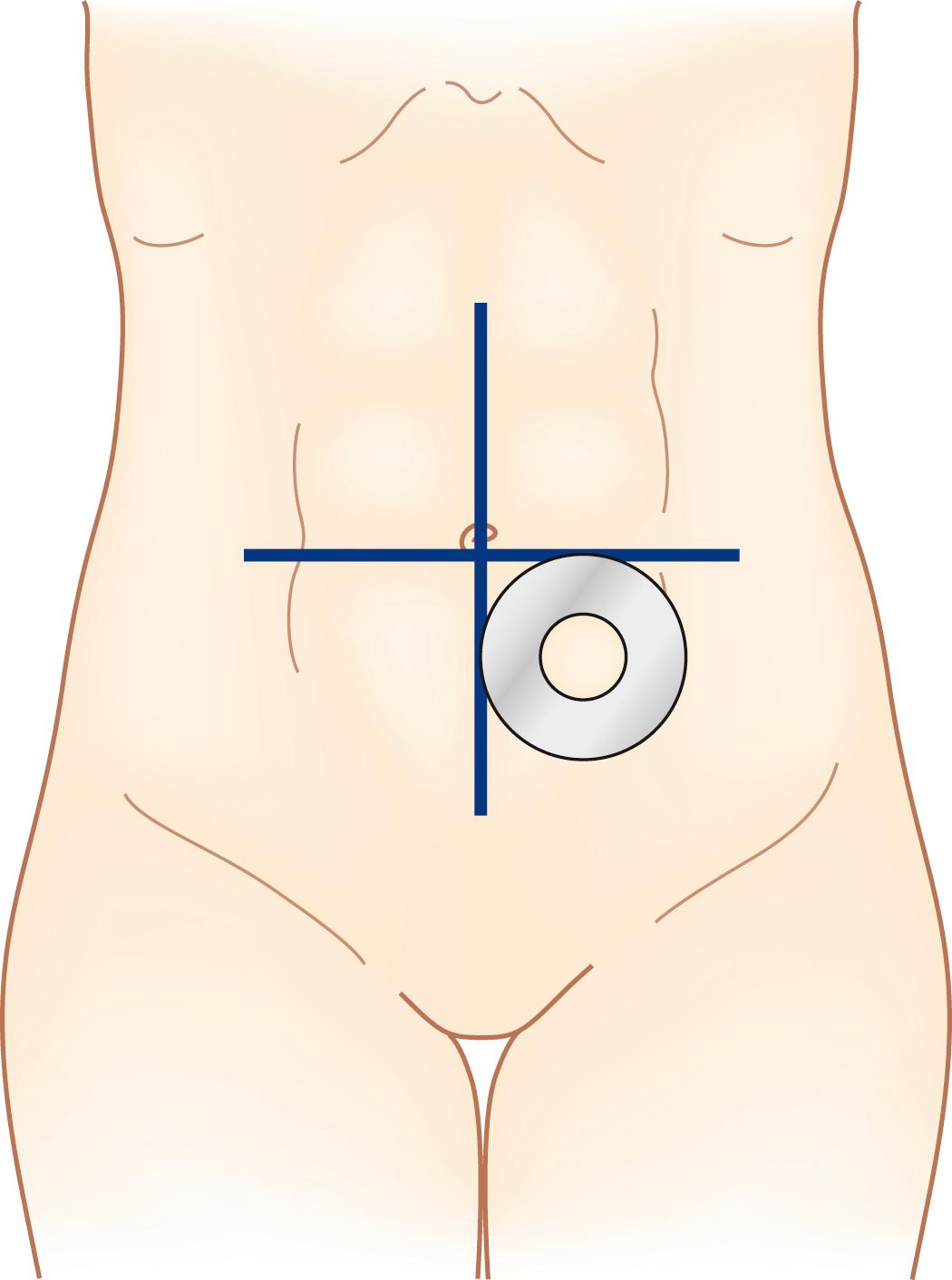
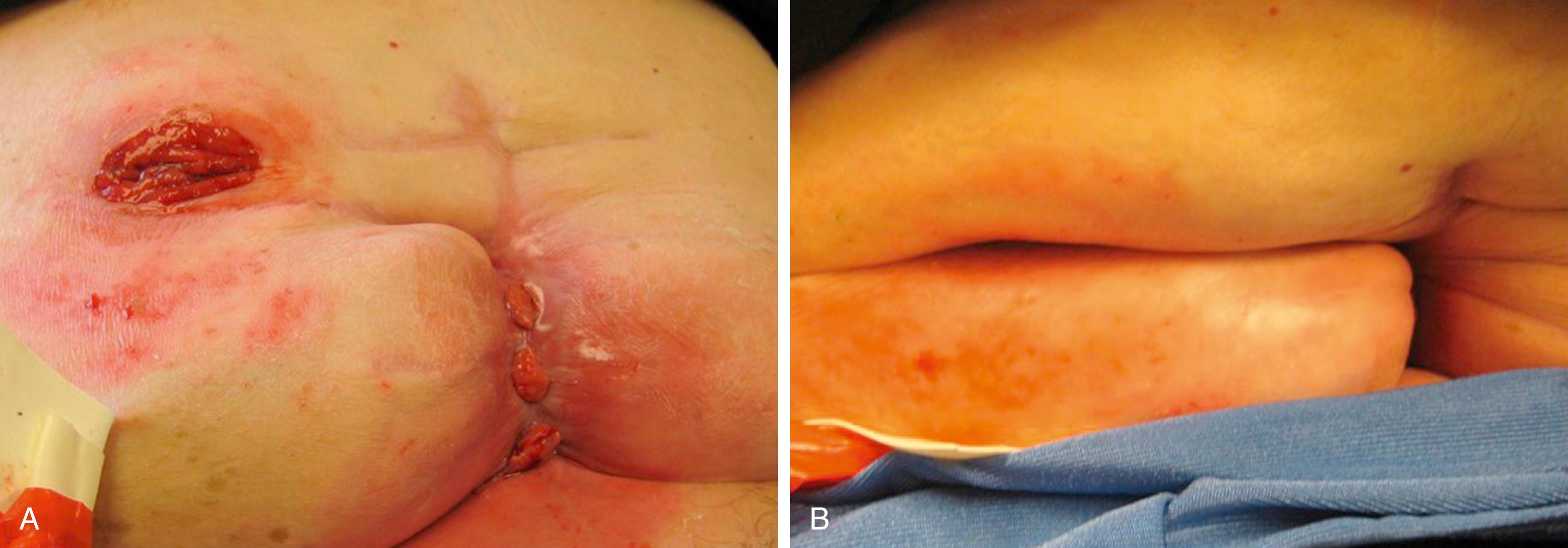
Many different types of stoma configurations can be chosen at the time of surgery. Stomas can be differentiated by whether they:
are small bowel stomas or colostomies
drain stool or urine
are temporary or permanent
are end, loop, or end-loop stomas.
Temporary stomas are often chosen to aid in anastomotic healing or in the presence of sepsis or other conditions, when it is not considered not safe to perform an unprotected anastomosis. Loop ileostomies are often chosen for temporary diversion due to their lack of odor, ease of care, and ease of closing. Loop descending or sigmoid colostomies can similarly easily be closed. Transverse loop colostomies should seldom be used, as they are large, very prone to prolapse, and can be difficult to maintain pouch adherence, frequently being located in an area around the patient’s belt line or mid-upper abdomen.
Temporary diversion can be performed for a number of situations. Most often, temporary diversion is used to aid in healing of distal anastomosis. Alternatively, diversion of the fecal stream is sometimes recommended in patients undergoing treatment of distal pathology, such as anal squamous cell carcinoma, in order to make the treatment (e.g., chemoradiation) more tolerable. In these scenarios, a diverting stoma is anticipated to be closed after healing of the anastomosis or after conclusion of treatment. Each of the three different types of stomas (end, loop, and end loop) has advantages and disadvantages. The consistency and amount of stoma effluent can differ significantly depending on:
whether the small bowel or the colon is selected for stoma construction
if the colon is selected, upon which site of the colon is selected for stoma construction
what types of treatment (radiation) the patient has undergone
previous bowel resection(s) the patient may have had.
Ascending colostomies tend to have a higher amount of liquid effluent, while descending and left-sided colostomies are usually preferable, as most of the colon is in circuit, allowing for more colonic water absorption, with a more formed effluent, while still providing proximal diversion.
With the increasing body mass index of patients in the United States today, creating a well-functioning stoma can be a challenge. Both early and late complications can occur with stoma construction. Remember, a stoma should look good at the end of an operation ! This is your best opportunity to address issues of stoma construction. One should not make the error of hoping that a suboptimal-appearing stoma will improve postoperatively. While edema secondary to obstruction may improve, ischemia does not and will only worsen over time. If there is doubt about stoma viability, construct the stoma prior to closing the abdomen, when revision is easy. A key aspect to creating a good stoma is to create a large enough aperture in the abdominal wall to allow the stoma to reach to the skin without tension, but not to create such a wide opening that the patient will develop a hernia at the site. Typically, creating an aperture that will admit two fingers is adequate ( Fig. 52.17 ). In addition, one should ensure that the patient is marked for a stoma site preoperatively, as was discussed earlier. It is important to create a muscle-splitting stoma aperture within the rectus muscle and sharply divide the rectus sheath ( Fig. 52.18 ). In creating a colostomy in an obese patient, especially with the left side of the colon, one frequently has to perform the same central vascular ligation as one does for a cancer resection merely to achieve the same degree of mobilization and mobility to enable the colon to reach to the abdominal wall in a tension-free manner. This can particularly be true with patients who have a very rigid abdominal wall and those with a very thick layer of subcutaneous tissue. In constructing an end colostomy, typically this does not need to protrude more than 0.5 to 1 cm above the level of the abdominal skin. However, there are some circumstances where the patient may be expected to have a more liquid effluent (e.g., due to receiving chemotherapy), and one may wish to have the stoma protrude more to permit easier pouch placement and adherence. In the presence of a liquid effluent, a protruding “spout-like” stoma is always easier to maintain pouch adherence compared with a flatter stoma. In the obese patient, it is sometimes easier to construct an end-loop colostomy than an end colostomy if complete fecal diversion is required. This is constructed in a similar fashion as a loop-end ileostomy (see later), whereby a loop of mesentery is brought up, rather than an end of mesentery. Remember, traditional loop colostomies are not always completely diverting. If one wishes total diversion, an end-loop stoma, with tacking of the distal limb in close proximity of the stoma site, may be a preferable option. Also remember that, in obese individuals, the thinnest part of the abdominal wall is often in the upper abdomen.
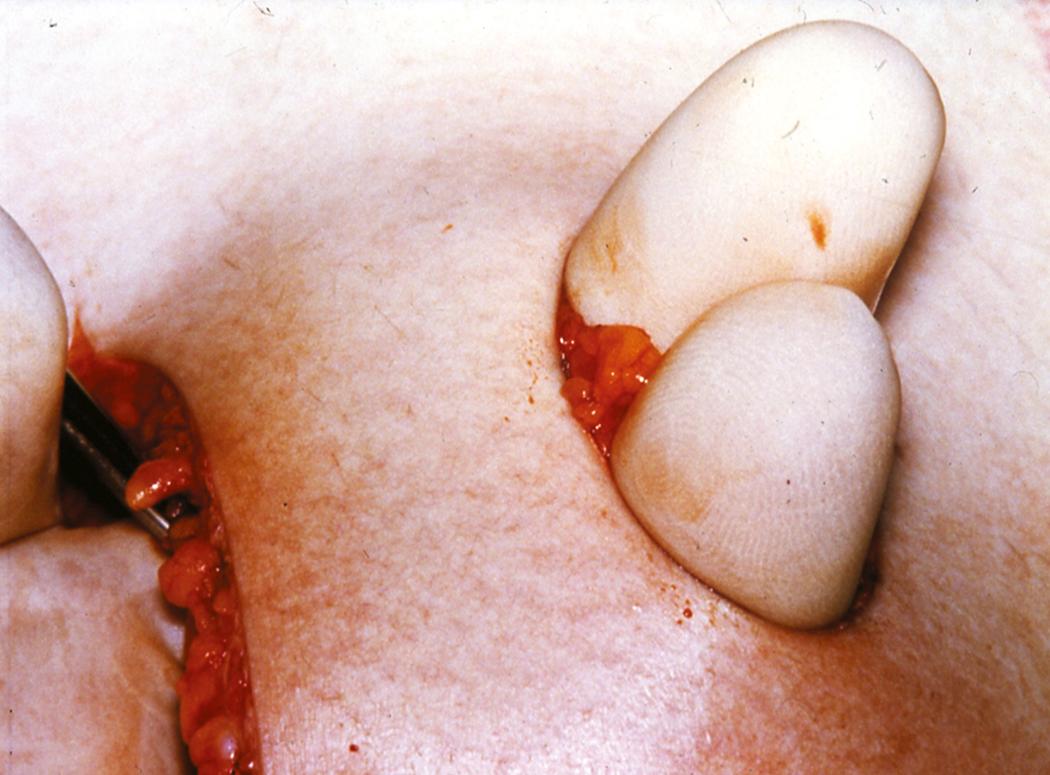

As with colostomy, an ileostomy can be constructed as an end ileostomy, loop, or end-loop ileostomy ( Fig. 52.19 ). Ileostomies are generally favored by colorectal surgeons for fecal diversion as they are easier to construct, especially in obese individuals, usually easier to close, and do not risk compromising the marginal vessels of the colon that are so important to the viability of low and ultra-low colorectal and coloanal anastomoses. Ileostomy effluent usually has no odor, in contrast to colostomy effluent, which usually has odor associated with colonic flora. However, in contrast to a colostomy, an ileostomy will empty continuously and has a high rate of associated chemical dermatitis due to the more alkaline pH associated with small bowel effluent as opposed to the stool of the colon. There is also a much higher risk of dehydration with an ileostomy, which is a frequent reason for hospital readmission following elective colorectal surgery. Prior to hospital discharge, one should ensure that the 24-hour stoma output is less than 1000 mL. If the output is greater than this amount, the patient is at high risk of hospital readmission.
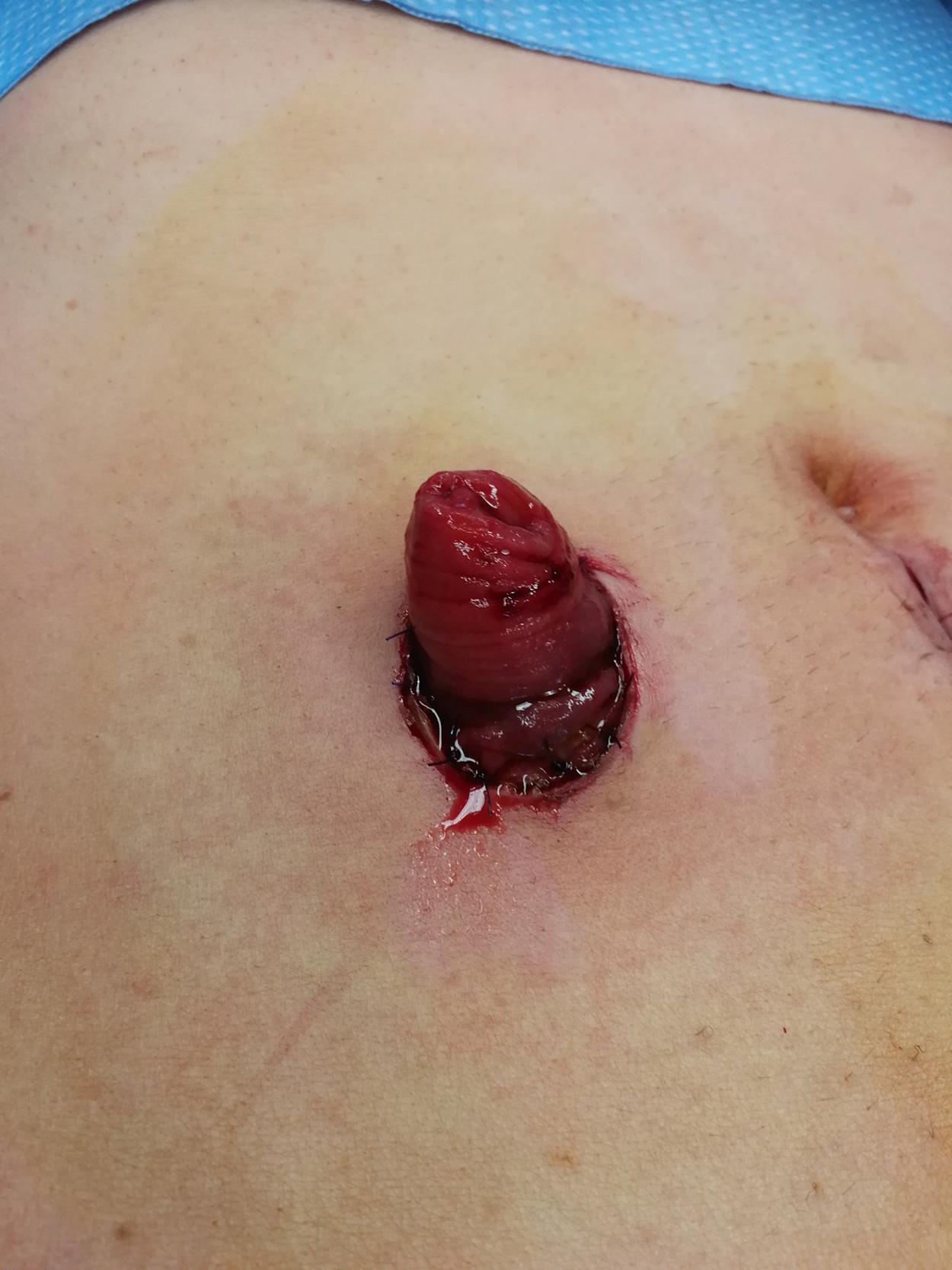
In patients in whom temporary ileostomy diversion is contemplated, wrapping the segment of diverted bowel in hyaluronate-carboxymethylcellulose membrane (Seprafilm) at the time of stoma creation facilitates stoma closure. Loop ileostomy is often performed at the time of ileal pouch–anal anastomosis (IPAA) in patients who are immunosuppressed and in those in whom there is tension on the anastomosis. It is also performed in cases of low colorectal and coloanal anastomosis following neoadjuvant chemoradiation, in some patients in whom complex pelvic reconstructions are performed (e.g., redo rectovaginal fistula repairs, repair of cloacal defects) and in other cases when temporary fecal diversion is desired. Laparoscopic-assisted diversion is particularly convenient for these cases.
The last edition of this textbook reported that protocols for enhanced recovery after surgery had not been widely implemented. Since that time, there has been much attention to enhanced recovery protocols (ERPs) in colorectal surgery with widespread dissemination and implementation in the community. These protocols, also called fast-track or enhanced recovery after surgery protocols , have been shown to reduce complications, length of stay, and cost of care without increasing readmission rates. Protocols include a bundle of components affecting the preoperative, intraoperative, and postoperative phases of care. The factors that comprise a single protocol are numerous and heterogeneous between centers, thus making it difficult to identify the most beneficial components in a bundled protocol. In 2017, the American Society of Colon and Rectal Surgeons (ASCRS) and the Society of American Gastrointestinal and Endoscopic Surgeons published evidence-based guidelines for the components of ERPs.
Counseling before surgery to set expectations on milestones and discharge criteria is considered a cornerstone of successful ERPs. If an ostomy is a part of the planned operation, marking, education, and counseling on dehydration should be started in the preoperative period. Ostomy creation is an independent risk factor for increased postoperative length of stay, and structured education has been shown to mitigate this risk. Additionally, dehydration is the most common reason for readmission after an ileostomy creation.
Prehabilitation or increasing the patient’s physical conditioning before elective surgery may be considered for patients with deconditioning or multiple comorbidities. The evidence to support prehabilitation is in evolution but appears promising.
There is strong evidence to support the recommendation of a clear liquid diet up until 2 hours before the induction of anesthesia. However, there is weaker evidence to support the use of per os carbohydrate loading prior to surgery.
Mechanical bowel preparation alone has not shown to be beneficial (strong recommendation based on high-quality evidence, 1A). In the United States, mechanical bowel preparation plus oral antibiotics preparation has become the preferred preparation to reduce complications, including SSIs, especially when left-sided and rectal resections are anticipated. In the American Society of Colon & Rectal Surgeons Clinical Practice Guidelines for the Use of Bowel Preparation in Elective Colon and Rectal Surgery, this practice was given a strong recommendation based on moderate-quality evidence, 1B. Interestingly, a recent randomized controlled trial found no evidence to support this practice for elective colon resection compared to no bowel preparation as a mechanism to reduce SSIs or postoperative morbidity. It is important to note that the majority of reported studies, including this one, were performed in patients undergoing colon as opposed to rectal resections.
ERPs commonly involve preset orders for the preoperative, intraoperative, and postoperative care for all patients. Standardization requires collaborative buy-in from different stakeholders, which helps avoid confusion and promotes timely adherence to care.
Colorectal surgery patients have up to a 20% risk of developing a SSI postoperatively. Bundles of care aimed at SSI reduction have shown SSI rates to be significantly reduced. These bundles include some, if not all, of the following measures: preoperative chlorhexidine shower, mechanical bowel preparation with oral antibiotics, prophylactic antibiotic administration within 1 hour of incision, the use of wound protectors during surgery, changing gown, gloves, and instruments before fascial closure, euglycemia, and normothermia. The degree to which each element impacts the reduction of SSIs is unclear.
There is strong evidence to support the use of multimodal, opioid-sparing, pain management plans starting before the induction of anesthesia. Minimizing opioids is associated with earlier return of bowel function and shorter length of stay. Acetaminophen, nonsteroidal antiinflammatory drugs (NSAIDs), and gabapentin have all been incorporated into various ERPs. Transverse abdominis plane block with local anesthetic, including liposomal bupivacaine, have shown promising results. Epidural analgesia is generally recommended for open, but not laparoscopic, colorectal surgery.
The use of goal-directed fluid therapy in the intraoperative and postoperative phases of care is associated with a reduction in time to return of bowel function and length of stay. Lastly, minimally invasive surgical (MIS) approaches should be used, when possible, with avoidance of routine use of intraabdominal drains and nasogastric tubes.
Early patient mobilization with early feeding has good evidence to support its role in an ERP. Alvimopan use has been shown to hasten return of bowel function after open surgery, but not with MIS. In addition, intravenous (IV) fluids and urinary catheters should be discontinued early in the postoperative period.
In summary, ERPs are evidence-based protocols that benefit colorectal surgery patients. Local implementation involves buy-in for a range of stakeholders that may be in opposition to the preferences of individual healthcare professionals. Adherence to the constellation of ERP components and the outcomes of interest should be continually monitored and evaluated.
Diverticular disease is used to describe a spectrum of manifestations associated with colonic diverticulosis. Diverticula are saccular outpouchings of the bowel wall. They are described as “true” diverticula when they contain all layers of the bowel wall; these are rare and usually congenital. The vast majority of diverticula in the colon are “false” diverticula (pulsion, pseudodiverticula), containing only the mucosa and muscularis mucosa. Diverticulitis is thought to be mainly a disease of the modern world, coinciding with dietary changes following the industrial revolution.
Hypertrophy of the muscular layers of the colon wall, combined with a narrowed lumen and disordered colonic motility, causes localized high-pressure zones in which the mucosa herniates through areas of relative weakness. Diverticula are classically formed on the mesenteric side of the colonic wall in regions where vasa recta traverse through the muscular layer to provide blood to the mucosa ( Fig. 52.20 ). The sigmoid and descending colon are typically affected, whereas the rectum, having an extra layer of muscle, is generally not affected ( Fig. 52.21 ). This has implications for surgery and is why the distal anastomosis margin in operations for diverticulitis should always be within the rectum. Diverticulosis increases with age and is relatively rare in young adults. Colonic diverticula are noted in approximately 40% of individuals between the ages of 50 and 60 years and in over 60% of individuals over the age of 80 years ( Fig. 52.22 ). The mechanism for developing diverticulitis is thought to be a result of obstruction of the orifice of a diverticulum, with stasis leading to bacterial overgrowth, inflammation, and increased pressure within the diverticulum, causing ischemia and microperforation. Interestingly, only a small proportion of patients with diverticulosis develop diverticulitis. Modern estimates indicate that fewer than 5% of patients with diverticulosis will develop diverticulitis; however, due to the high prevalence of diverticulosis, it has become a significant clinical and financial burden, accounting for more than 2.7 million outpatient visits in the United States annually and more than 200,000 inpatient admissions for diverticulitis at an estimated cost of more than $2 billion.
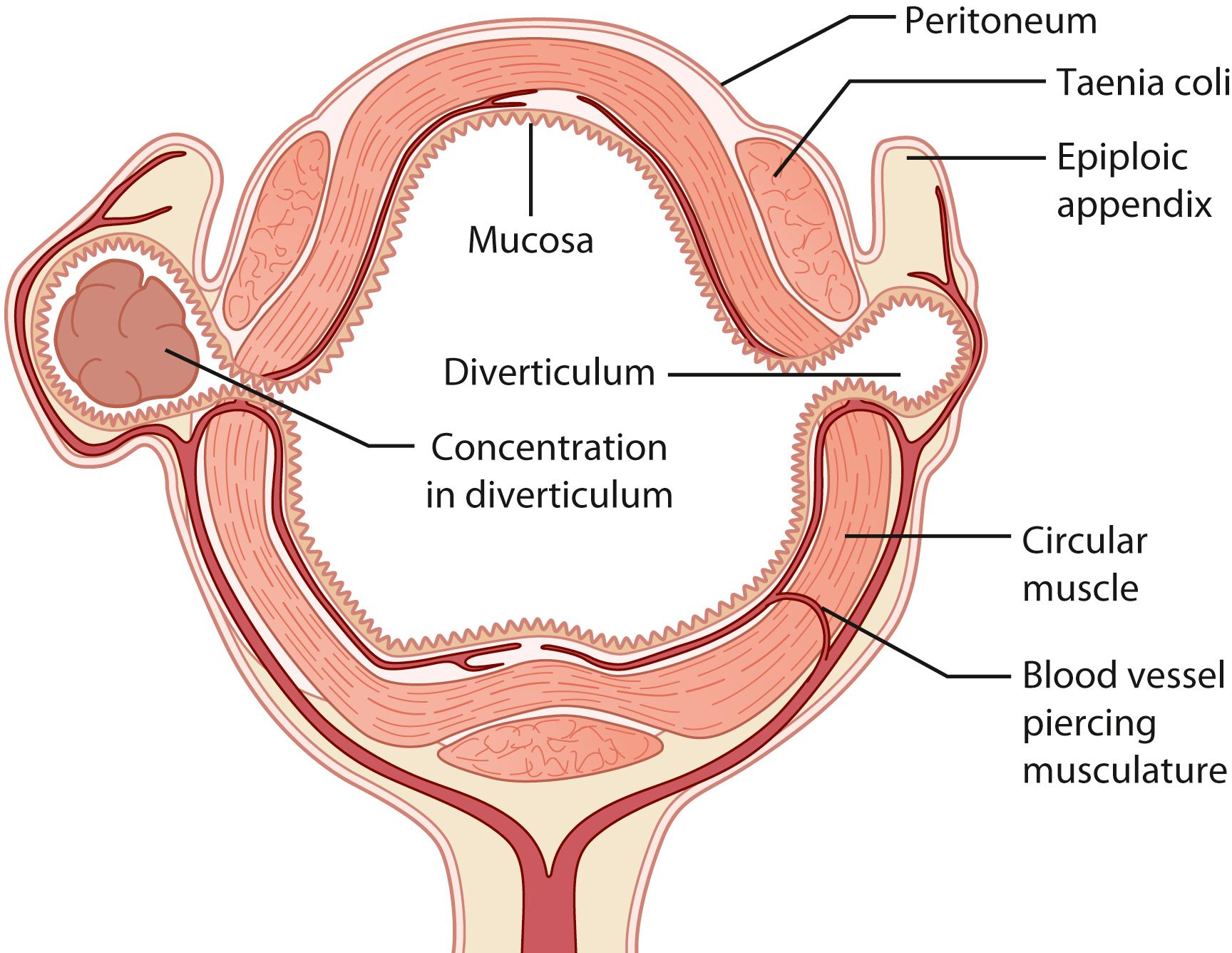
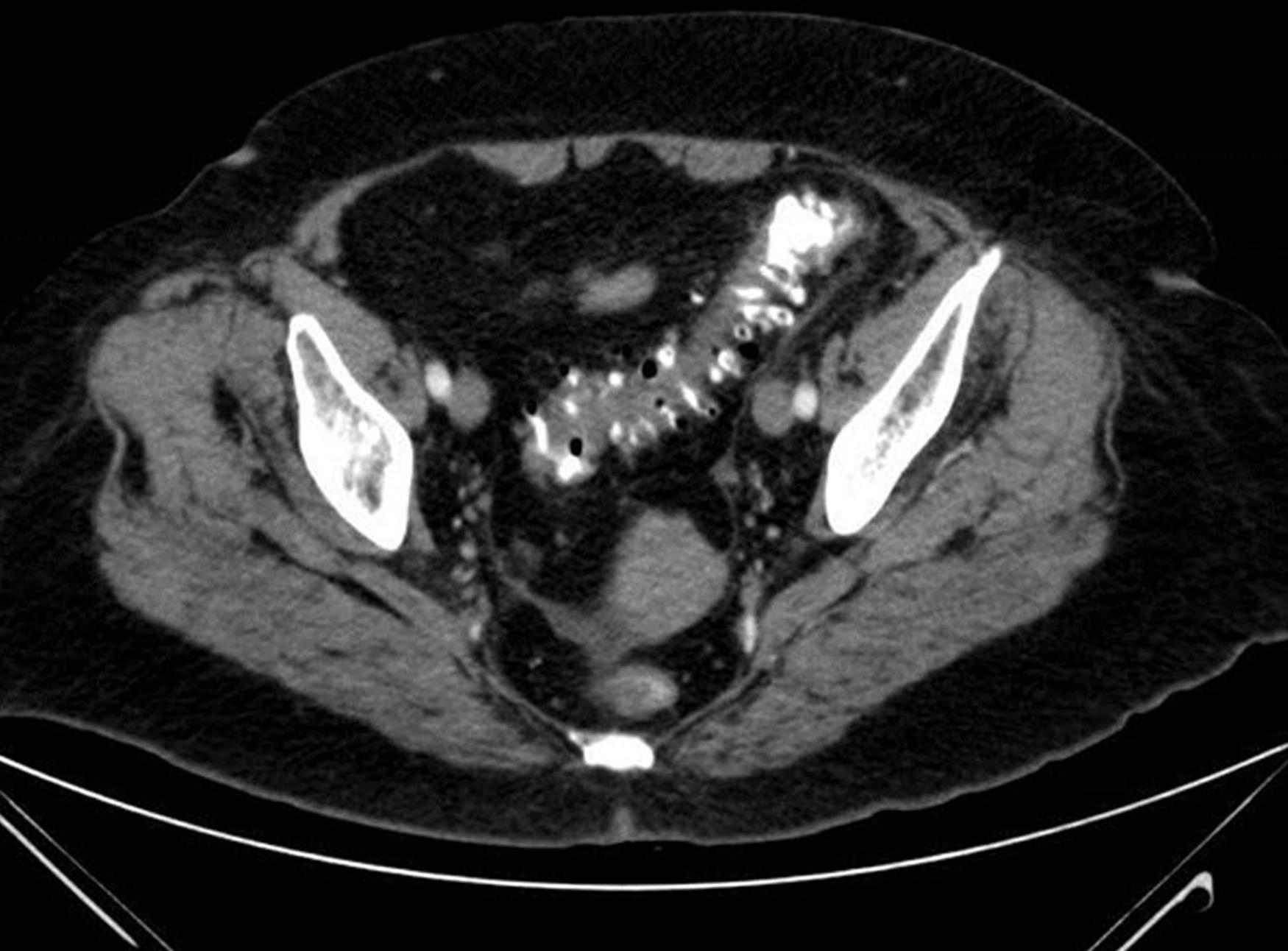
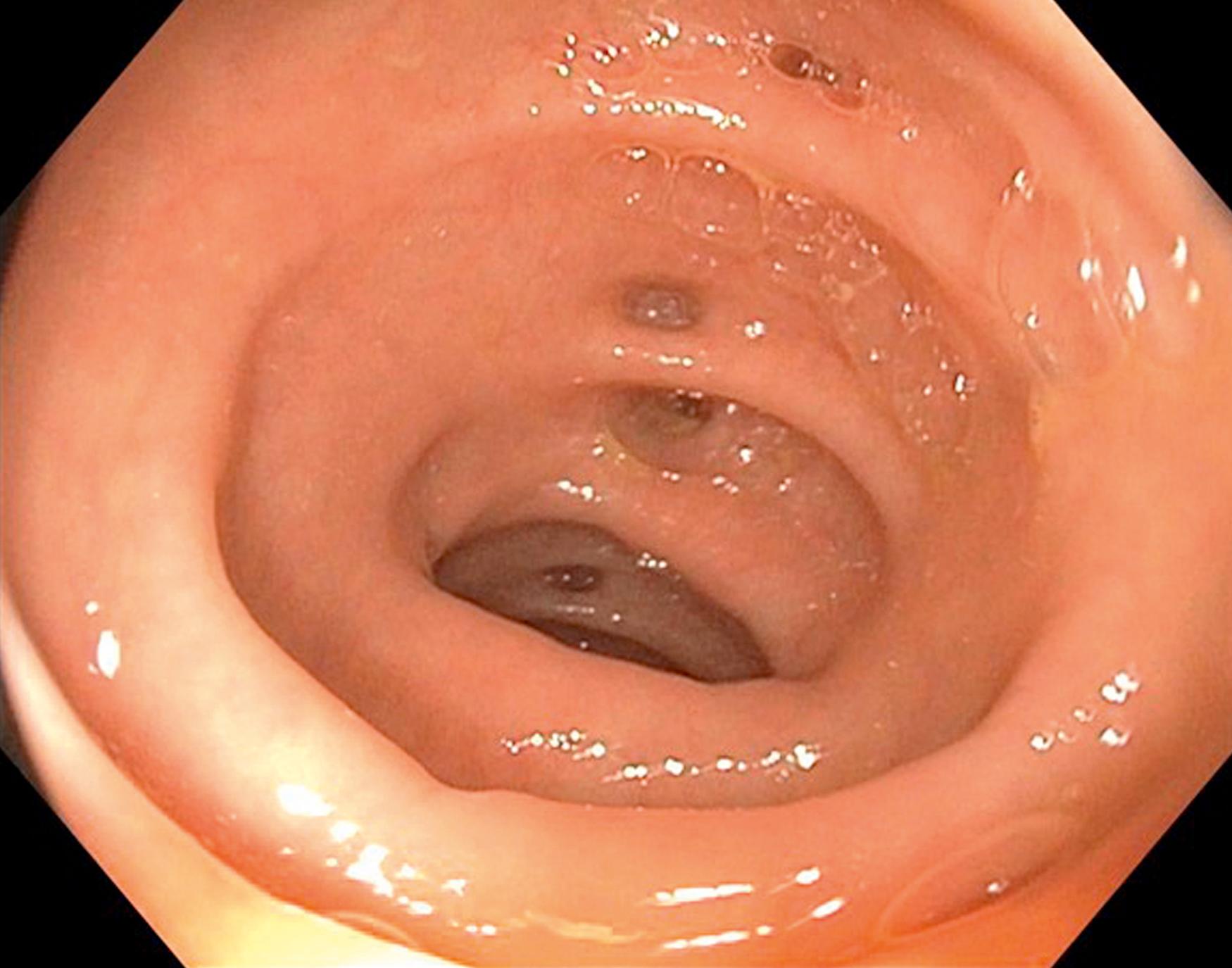
Diet and lifestyle factors play an important role in diverticular disease. Western dietary patterns high in red meat, fat, and refined grains are associated with an increased risk of the disease, whereas increased fiber intake, with abundant fruit, vegetables, and whole grains, reduces the risk of diverticulitis. Intake of nuts, seeds, and popcorn does not appear to increase the risk. Central obesity and smoking increase the risk, whereas physical activity such as running has been correlated with a decreased risk. A study examining the joint contribution of multiple lifestyle risk factors, defined as fewer than four servings of red meat per week, at least 23 g of fiber per day, 2 hours of vigorous activity per week, a body mass index 18.5 to 24.9 kg/m 2 , and no history of smoking on the risk of incident diverticulitis, found that adherence to a low-risk lifestyle could prevent 50% of incident diverticulitis.
Diverticular disease can manifest as diverticulitis, but it is also the most common reason for severe lower GI bleeding (discussed elsewhere). Since diverticulitis is caused by inflammation and perforation of a colonic diverticulum, signs and symptoms will generally result from the pericolonic inflammation. Patients will commonly present with abdominal pain localized to the left lower quadrant (following the location of the inflamed sigmoid colon). Additionally, fever, change in bowel habits, anorexia, and urinary urgency (in cases where the bladder is secondarily inflamed) are frequent. On physical examination, localized tenderness is noted, commonly with moderate abdominal distension. A tender mass can be palpable if there is a significant phlegmon. Rectal bleeding is rare in the presentation of acute diverticulitis and should raise suspicion of another diagnosis such as ischemic colitis or IBD. Leukocytosis is a common laboratory finding.
Several imaging modalities have been used to evaluate patients with suspected diverticular disease. Flat and upright plain films can be used to diagnose obstruction or free intraperitoneal air but are generally nonspecific. Contrast studies, ultrasound, and magnetic resonance imaging (MRI) have also been used, but currently, computed tomography (CT) has become the most useful examination to confirm the diagnosis, exclude other diagnoses, and classify the severity of the disease. Signs of diverticulitis on CT include the presence of diverticula, colonic wall thickening, pericolic fat stranding, and abscess formation. CT studies have the capacity to localize abscesses and fistulas and define the extent of the disease. The modified Hinchey classification is the most commonly used tool to describe the severity of diverticulitis ( Table 52.1 ).
| Stage 0 | Mild clinical diverticulitis |
| Stage Ia | Confined pericolic inflammation—phlegmon |
| Stage Ib | Confined pericolic abscess (within sigmoid mesocolon) |
| Stage II | Pelvic, distant intraabdominal or intraperitoneal abscess |
| Stage III | Generalized purulent peritonitis |
| Stage IV | Fecal peritonitis |
Grade 0, not included in the original publication, is commonly used to describe mild clinical diverticulitis. If CT is performed, colonic wall thickening without pericolonic fat stranding can be seen. Grade 1a presents with a phlegmon with colonic wall thickening and pericolonic fat stranding, while grade 1b also includes a pericolonic or mesocolic abscess ( Fig. 52.23 ). Patients with grade 2 disease have distant intraabdominal or pelvic abscesses. Patients with grade 3 disease have generalized purulent peritonitis, and grade 4 disease, fecal peritonitis. The ability of a CT scan to distinguish between grade 3 and grade 4 is limited, and in these cases, accurate diagnosis is usually made in the operating room.
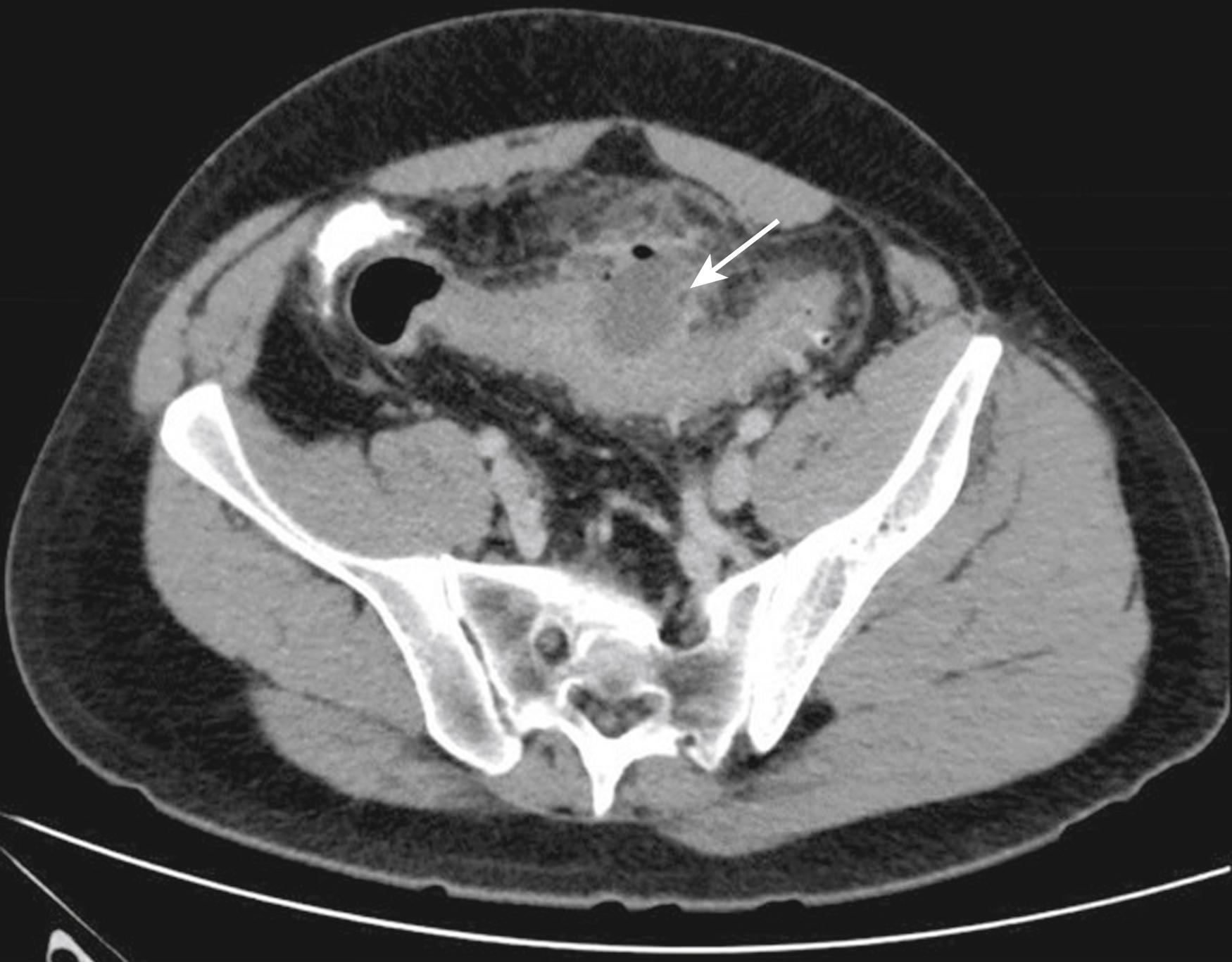
Flexible endoscopy during the acute setting should be approached with caution because distention of the colon may result in worsening perforation.
Patients with complicated diverticulitis are characterized by the presence of an abscess, fistula, obstruction, or free perforation.
Signs and symptoms will depend on the size and location of the abscess, with diagnosis usually provided on imaging. Smaller abscesses can often be treated successfully with antibiotics alone. Larger abscesses will require drainage. Following recovery, elective surgery is generally recommended; however, some of these patients, especially those with smaller abscesses that were treated without drainage, can probably be managed nonoperatively. Patients with abscesses not amenable to percutaneous drainage and unresponsive to treatment require urgent surgery.
Fistulas are abnormal connections to surrounding epithelial lined organs and are a relatively common complication of diverticulitis. They are a result of the local inflammation and development of an abscess that decompresses into a neighboring organ. The most common type, especially in men, is a colovesical fistula to the dome of the bladder. Patients will present with recurrent urinary tract infections, which are in many cases polymicrobial. Pneumaturia and fecaluria may also be present. CT can reveal air or contrast in the bladder in the absence of prior instrumentation. Cystoscopy will usually disclose inflammation at the site of the fistula. Colovaginal fistulas occur almost exclusively in women who have undergone previous hysterectomy and present with vaginal discharge and passing of air per vagina. Colocutaneous fistulas usually present at a previous drain site in patients who have undergone percutaneous drainage. Patients with fistulas usually do not need emergency surgery as the abscess has usually decompressed. Initial management includes broad spectrum antibiotics to decrease the inflammation. Patients are then investigated with colonoscopy and appropriate imaging (i.e., cystoscopy) to exclude malignancy and Crohn disease. Surgical principles then encompass resection of the involved colon and fistula tract with primary anastomosis. If possible, the fistula opening into the secondarily involved organ is primarily suture repaired; however, in many cases, the opening is small and difficult to recognize. In the case of the bladder, with small fistula openings, drainage of the bladder with a Foley catheter for 7 to 10 days will usually allow for healing. A cystogram can be done to confirm fistula healing prior to Foley removal. Fistulas to the small bowel will characteristically require resection and primary anastomosis.
Patients with recurrent and chronic diverticulitis can develop fibrosis of the colonic wall, leading to stricture formation. In most cases, these patients will present with insidious symptoms and a partial obstruction. Small bowel obstruction may also be seen as a result of a small bowel loop adhering to an area of inflamed colonic tissue or abscess. Management depends on the degree and type of obstruction. Patients with a partial obstruction can usually be initially treated with a nasogastric tube for decompression, antibiotics, fluids, and bowel rest. If the obstruction resolves, elective resection can be planned. It is usually important, prior to resection, to perform a colonoscopy to rule out malignancy. In cases where the stricture is impossible to pass using a colonoscope, virtual colonoscopy or a retrograde contrast study can be helpful to visualize the remainder of the bowel. Patients with a complete obstruction unresponsive to therapy will require emergency surgery.
Patients with a free intraabdominal perforation with widespread contamination will present with diffuse peritonitis with rebound tenderness and guarding. Signs of sepsis including fever, tachycardia, and hemodynamic instability are frequently seen. Imaging can demonstrate free abdominal fluid, signs of peritonitis, and free intraabdominal air. The ability to distinguish between purulent and fecal diverticulitis prior to surgery is limited. Hinchey grades 3 and 4 are considered a surgical emergency. Following initial resuscitation, patients are taken to the operating room with a goal of controlling the source of infection by resection and washing out the abdominal contamination.
The mainstay of treatment in these cases has traditionally been the Hartmann procedure, which removes the involved colon and exteriorizes an end colostomy. Reversing the colostomy, however, requires a second major surgical procedure with its own significant morbidity and mortality. Practically, up to 50% of patients will never be reversed, with even higher rates in the elderly. Given these implications, several studies have investigated alternatives to the Hartmann procedure. One option has been laparoscopic lavage, which entails laparoscopic irrigation of the abdominal cavity to reduce the abdominal contamination and placement of drains without resection (mainly for Hinchey grade 3 diverticulitis). Although this approach results in lower stoma rates, it has been associated with significantly higher rates of ongoing and recurrent sepsis and emergency reoperations. This approach is still controversial and should probably only be used in highly selected individuals. Another option is performing a resection with a primary anastomosis and diverting ileostomy. Although lengthening the initial surgery, this technique has been found to be safe and significantly simplifies and shortens the second operation. Overall morbidity and mortality are similar; however, a much higher proportion of patients will have their stomas reversed (94%–96% for primary anastomosis vs. 65%–72% for Hartmann). This has become an attractive option for patients who are stable enough to withstand the additional time of the initial surgery.
The treatment for uncomplicated diverticulitis depends on the severity of symptoms, and the approach is subsequently individualized. The majority of these patients can be managed as outpatients. The mainstay of treatment is based on pain medications, short-term alteration of diet, and antibiotics. Commonly, patients are initially prescribed clear liquids, followed by a low-residue diet until the inflammation subsides. Antibiotics have traditionally been prescribed to cover colonic bacteria. A systematic review and metaanalysis assessing the effect of antibiotic administration in patients with uncomplicated diverticulitis has not shown the usage of antibiotics to accelerate recovery or prevent complications or subsequent surgery. As a result, some physicians have stopped prescribing antibiotics for uncomplicated diverticulitis.
A small proportion of patients diagnosed with diverticulitis will actually have a colonic neoplasm mimicking diverticulitis. Overall, this is currently estimated at around 1% to 3%, with significantly higher rates observed in complicated disease. Upon recovery, it is recommended that patients undergo a colonoscopy after 4 to 8 weeks to exclude malignancy.
Following the initial episode of acute, uncomplicated diverticulitis, only 10% to 35% of individuals will have another episode. After more episodes, the chances of recurrence increase significantly. In an attempt to avoid severe complicated diverticulitis, elective surgery was previously suggested following uncomplicated diverticulitis, depending on the number of episodes, with the thought that more episodes would lead to more chances of recurrence and a higher chance of severe complicated diverticulitis. However, recurrences in general tend to follow the severity of the initial episode. As a result, the number of attacks of uncomplicated diverticulitis has fallen out of favor as an indication for surgery. Currently, an individual assessment is performed on the frequency of attacks, ongoing symptoms, and their effect on quality of life versus the age and medical condition of the patient and their surgical risk.
The aim of elective surgery is to remove the affected segment of the colon (usually the sigmoid colon) and to perform a primary anastomosis of the healthy remaining bowel. When removing the sigmoid colon, the proximal margin should be in soft pliable bowel, but it is not necessary to include all proximal diverticula. The distal anastomosis, however, should be to the upper rectum, since leaving a section of distal sigmoid colon is associated with a higher risk of recurrent diverticulitis. Surgery can be performed by either an open, laparoscopic, hand-assisted, or robotic approach. MIS for diverticular disease has been shown to be safe, with advantages of more rapid recovery of bowel function, less pain, and shorter hospitalization.
This is common in Asian countries but rare in the west. This typically affects younger patients and may be challenging to diagnose as signs and symptoms are very similar to those of acute appendicitis. Other differential diagnoses to be considered include Meckel’s diverticulitis, cholecystitis, ischemic colitis, mesenteric adenitis, pyelonephritis, and pelvic inflammatory disease. The recommended approach should generally be similar to that for diverticulitis in other sites. Patients who have recurrent episodes or complicated disease and patients with an uncertain diagnosis should be considered for resection with a right hemicolectomy.
Immunocompromised patients include transplant patients; patients with diabetes mellitus, renal failure, or cirrhosis; and patients being treated with systemic steroids and/or chemotherapy. While the prevalence of diverticulitis in these patients is similar to the general population, they are more likely to present with free perforation and complicated disease because of their impaired ability to mount an inflammatory response. Because of this risk, there should be a lower threshold for resection after a single attack of diverticulitis. Immunocompromised patients who require emergency surgery and resection should probably not undergo primary anastomosis at the initial surgery because of their impaired immune system and healing.
Historically, patients younger than 50 were considered to have a more virulent form of diverticulitis and were recommended to undergo resection after one episode of uncomplicated disease. Although current evidence does demonstrate higher rates of recurrence, young patients do not have a higher rate of emergency surgical intervention. Current guidelines do not support treating young patients differently than others.
Large bowel obstruction, defined as bowel obstruction distal to the ileocecal valve, can occur as a result of a variety of etiologies. Broadly, it is classified into mechanical (dynamic) obstruction and functional (adynamic or pseudoobstruction). Mechanical obstruction can be further characterized into endoluminal, mural, and extraluminal causes ( Box 52.1 ).
Intrinsic mass—neoplasm
Foreign body
Bezoar
Fecal impaction
Diverticular stricture
Crohn disease stricture
Ischemic stricture
Radiation stricture
Infectious (i.e., lymphogranuloma venereum, tuberculosis, schistosomiasis)
Hirschsprung disease
Sigmoid volvulus
Cecal volvulus
Hernia (inguinal, ventral, internal)
Metastatic/intraabdominal tumor
Abdominal abscess
Retroperitoneal fibrosis
Adhesions (rare in large bowel)
Colonic pseudo-obstruction (Ogilvie)
Toxic megacolon
Paralytic ileus
The most common etiology of mechanical obstruction in the United States is colorectal cancer (CRC), whereas colonic volvulus is more common in Russia, Eastern Europe, Africa, the Middle East, and India. Presentation and symptoms depend on whether it is an acute obstruction or a more chronic progressive change, as well as partial, in which some gas/fecal contents are able to pass versus complete obstruction in which nothing passes distally. It is thought that worldwide, volvulus is responsible for roughly one third of the cases of large bowel obstruction. The most common site of volvulus is the sigmoid colon; however, cecal volvulus can also occur. Any portion of the colon that is not fixed to the retroperitoneum and that has an elongated mesentery has the potential for volvulus. In these cases, there is an axial twisting of the colon around the mesentery resulting in an obstruction.
Mechanical obstruction will generally present with increased peristalsis and low-grade colicky pain, but late, long-lasting obstruction may have decreased bowel sounds. In addition, patients will fail to pass stool and flatus and demonstrate increasing abdominal distention. Acute obstructions tend to present more dramatically with rapid onset of pain, distension, and abdominal tenderness, whereas patients with progressive obstruction may present with increasing constipation, pencil-thin stools, and intermittent abdominal pain. Functional obstruction usually presents with distension, vague abdominal pain, and weak or absent bowel sounds.
Patients with a closed-loop obstruction in which both the proximal and distal parts of a segment of bowel are blocked must be promptly recognized and treated, as they have the potential for ischemia and perforation with rapid deterioration. Closed-loop obstruction is commonly encountered in cases such as volvulus and strangulated hernias. Fig. 52.24 shows a plain film of a patient with a sigmoid volvulus. Note the bent, inner-tube appearance of the colon. The volvulus has resulted in a closed-loop obstruction. In these situations, the colon becomes progressively distended with pressure increasing to the point of ischemic necrosis and perforation. Fig. 52.25 shows a CT scan illustrating the characteristic mesenteric whorl seen in patients with a volvulus.
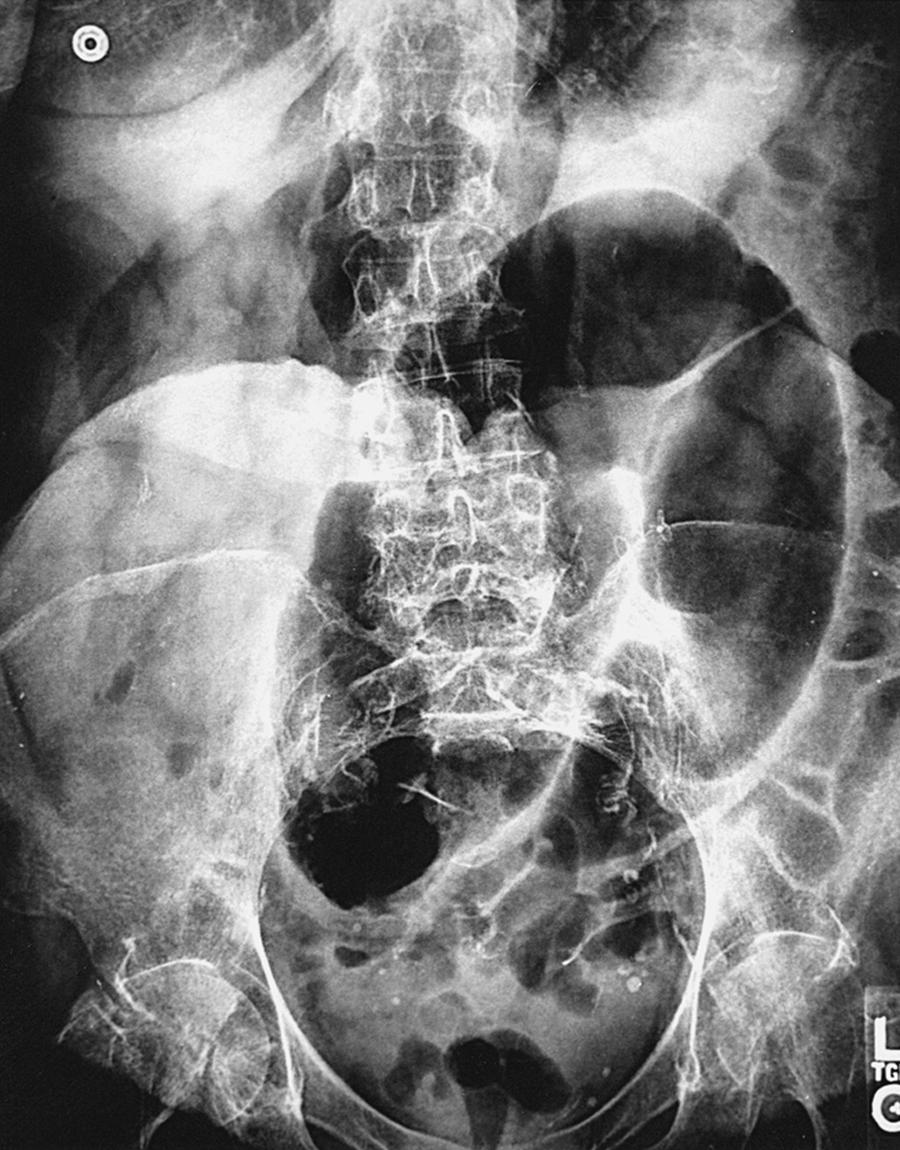
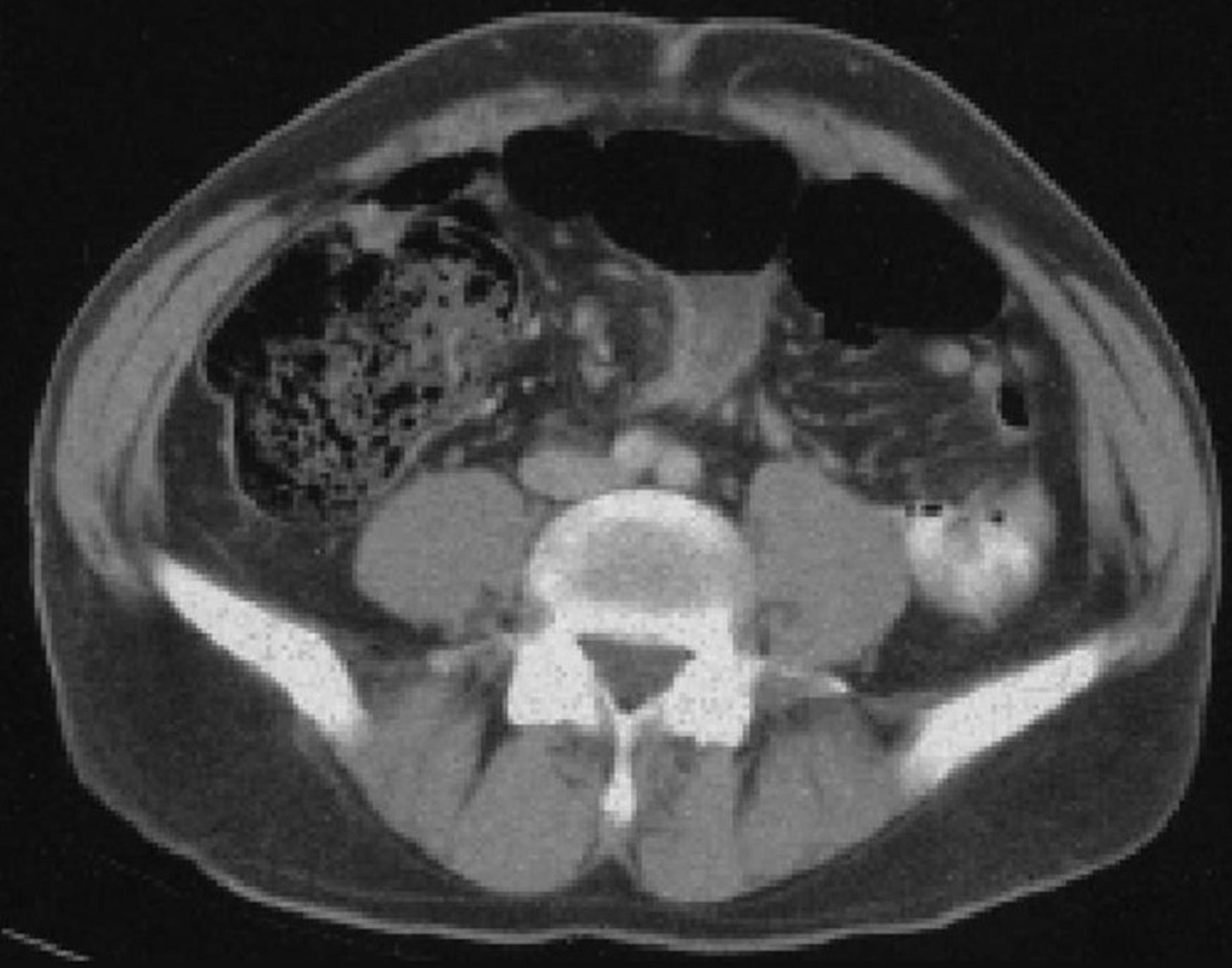
Another common circumstance of closed-loop obstruction is patients with obstructing colon cancers that have a competent ileocecal valve, which does not allow backflow of intestinal contents. Obstructing cancers with an incompetent ileocecal valve will usually present less acutely, with a much lower chance of perforation as the valve allows backflow of intestinal contents into the small bowel, resulting in a progressively distended abdomen with nausea and vomiting of a feculent nature.
Distention of the colon occurs as a result of gas and stool that gather proximal to the obstruction. The gas originates both from swallowed air (around two thirds) and bacterial fermentation. In segments that undergo increasing distension, the pressure within the bowel wall can rise above the capillary pressure, diminishing adequate oxygenation, leading to ischemic necrosis and perforation. Although most malignant obstructions occur in the distal parts of the colon, the necrosis and perforation usually occur in the cecum as it has the largest diameter, and in accordance with the law of Laplace will distend more under lower pressures and develop higher wall stress.
In cases such as incarcerated hernias and volvulus, pressure on the mesentery can compromise the blood supply initially obstructing venous return, and with increasing edema and inflammation, eventually occluding the arterial blood supply. The resultant ischemia can also lead to early necrosis and perforation. In closed-loop obstructions, distention initially involves the trapped or incarcerated segment, but with time, the proximal bowel will also distend as a result of ongoing accumulation of gas and stool.
A good history and physical examination are critical in the diagnosis of large bowel obstruction. The onset and progression of symptoms, background illnesses, and medications can provide important clues. The abdomen should be palpated for masses, tenderness, and previous incisions; the groins should be examined for hernias; and a digital rectal examination should be performed to inspect for neoplasms and for the presence of fecal impaction ( Fig. 52.26 ).
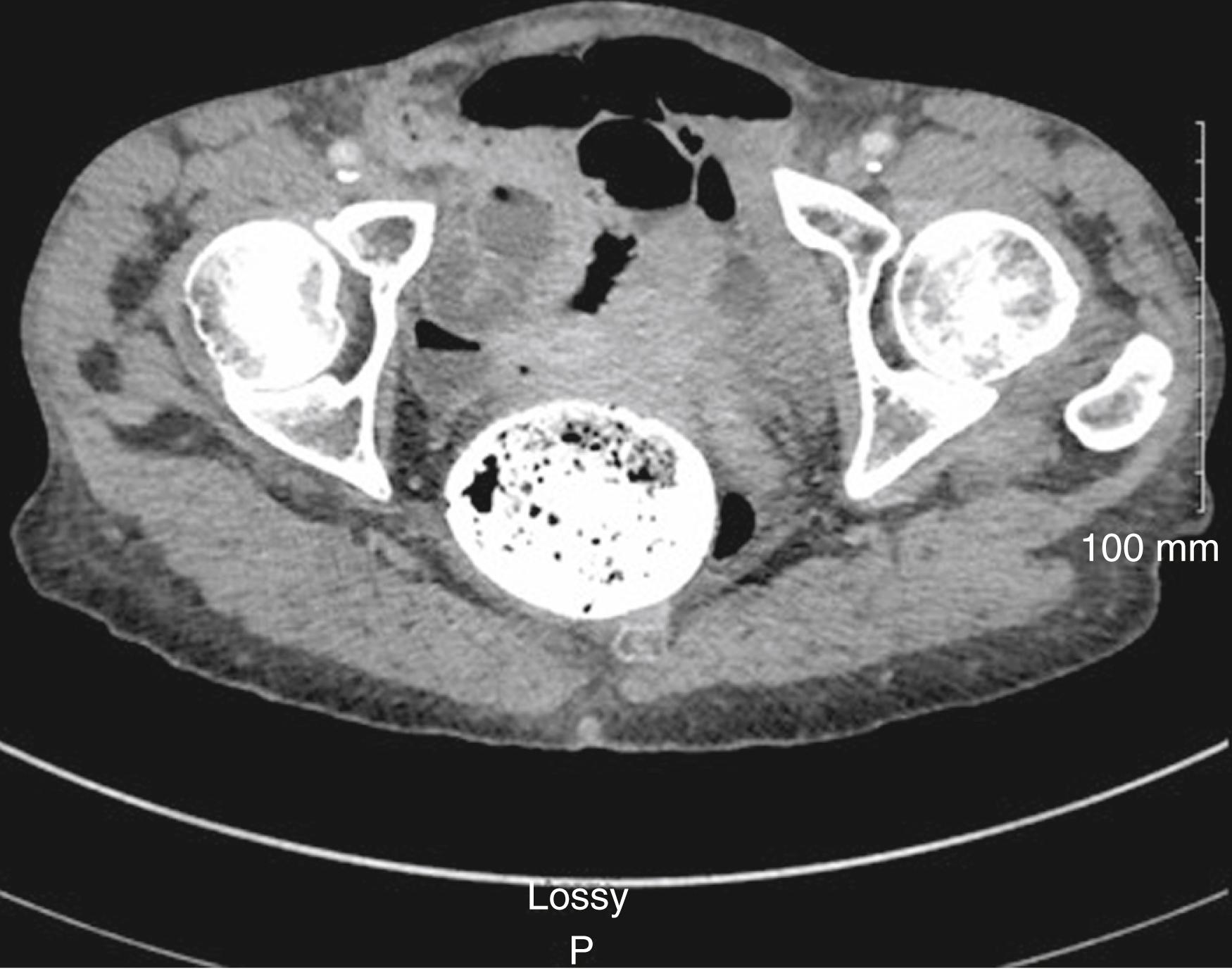
Plain films of the abdomen can help in localizing the obstruction, demonstrating the degree of distension as well as the status of the ileocecal valve (competent vs. incompetent), and, in some cases, provide the diagnosis. Water-soluble and IV contrast-enhanced CT scans provide significant information revealing the location and etiology of the obstruction such as diverticulitis, IBD, and extraluminal causes (e.g., abscesses and inflammation) ( Fig. 52.27 ). CT can also provide clues regarding tissue ischemia and impending perforation. Flexible endoscopy can assist in the diagnosis of the obstruction and permit biopsies to be collected for further investigation. Endoscopy can also allow for treatment such as detorsion of a sigmoid volvulus and insertion of stents in cases of malignant or benign obstruction. Basic blood analyses are also important in the initial workup. Electrolyte abnormalities can be diagnosed, which are important both as a cause for adynamic nonfunction and being in the operative and perioperative care. Increased white blood cell counts and CRP, as well as increased lactate, base excess, and decreased pH, are all generally associated with a more severe state and can help guide the aggressiveness of treatment.
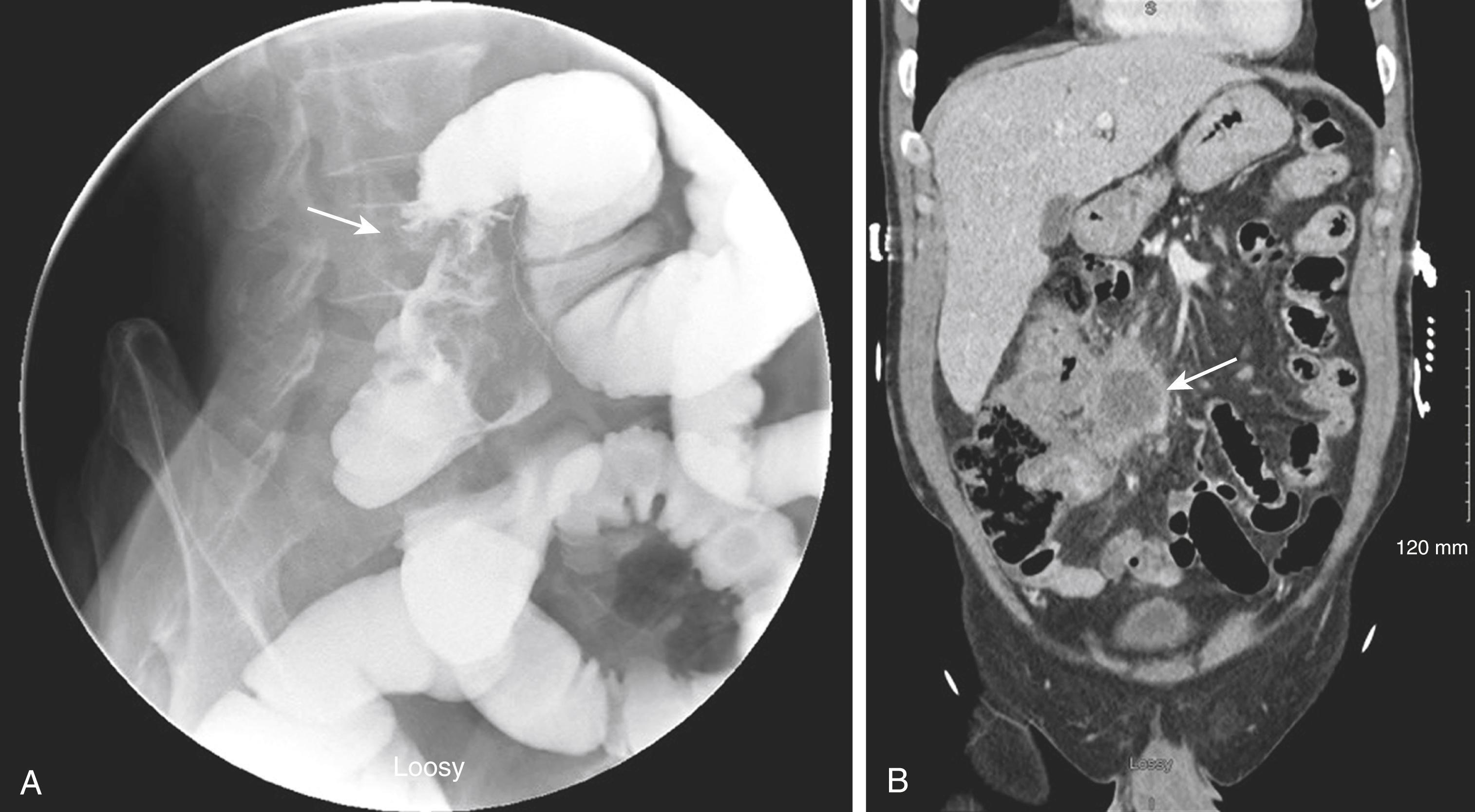
The treatment of large bowel obstruction is tailored to the etiology of the obstruction, several of which are discussed in detail later in the chapter. Treatment options vary considerably depending on the cause of obstruction, suspicion of bowel ischemia, and impending perforation, as well as the patient’s general condition and comorbidities. Patients who present with peritonitis, signs of perforation, or ischemic bowel should be taken immediately to surgery.
It is imperative to promptly relieve mechanical obstructions, particularly those with complete and closed-loop obstructions before compromise of the blood supply results in necrosis and perforation. Patients who do not present with immediate, ominous signs can be managed according to the cause of obstruction. In patients with sigmoid volvulus, endoscopic decompression is often successful using either a rigid or flexible sigmoidoscope with placement of a rectal tube proximal to the point of torsion. If this is unsuccessful, patients require surgery with resection, colostomy, and a Hartmann procedure. If decompression is successful, elective sigmoid resection with primary anastomosis should be performed due to the high rate of recurrence. With cecal volvulus, primary resection and anastomosis can typically be performed unless the patient is at increased risk of anastomotic leak (e.g., nonviable bowel, sepsis, hypotension, etc.). Patients with obstruction as a result of active IBD will commonly respond initially to steroids. Paracolic abscesses can be drained percutaneously. Foreign bodies can usually be removed endoscopically. Fecal impaction is commonly relieved with a combination of stool softeners and laxatives from above and manual disimpaction at the bedside or in the operating room under anesthesia. Hernias causing mechanical large bowel obstruction usually require surgery. Adult colonic intussusceptions, in contrast to pediatric intussusceptions, are almost always associated with a pathologic lead point, such as a polyp, cancer, Meckel, or colonic diverticulum. A recent meta-analysis found malignancy as the causative factor in 36.9% of ileocolonic and 46.5% of colonic intussusceptions. Most authors recommend surgical resection adhering to oncologic principles without reduction.
Patients with malignant obstruction of the low and mid rectum usually require an initial diverting stoma to allow for neoadjuvant chemoradiation prior to definitive surgery. Malignant obstructions of the sigmoid and left colon without signs of impending perforation can be treated with initial endoscopic stenting as a bridge to surgery, or initial surgery. Surgical options include segmental resection with Hartmann operation (end colostomy with internal closure of the rectal stump) or primary anastomosis with or without a diverting stoma. If the cecum is ischemic or nonviable, a subtotal colectomy is performed. In cases of right-sided obstruction, a right hemicolectomy is typically performed with primary anastomosis. Patients who are unstable with a high risk for anastomotic failure should undergo creation of a temporary diverting stoma or exteriorization of the anastomosis as a loop ileostomy.
Acute colonic pseudo-obstruction, also termed Ogilvie syndrome, was initially described by Sir William Heneage Ogilvie in 1948. It is characterized by acute colonic dilatation in the absence of a mechanical obstruction. Ogilvie syndrome is rare, with an estimated incidence of 100/100,000 admissions. Dysregulation of the colonic autonomic innervation is hypothesized to play an important part. Several mechanisms have been implicated including autonomic imbalance with a relative excess of sympathetic over parasympathetic activity, disrupted colonic reflex arcs, chronic disease, and medications.
It is most commonly encountered among elderly and comorbid patients, classically following an acute illness on a background of neurologic, cardiac, or respiratory diseases. Common associated conditions are depicted in Table 52.2 .
| Category | Risk Factors |
|---|---|
| Postsurgical | Following major orthopedic and/or spinal surgery, solid organ transplants, cardiac procedures |
| Neurologic disease | Parkinson disease, Alzheimer disease, stroke, spinal cord injury |
| Cardiac | Congestive heart failure, myocardial infarction |
| Pulmonary | Chronic obstructive pulmonary disease |
| Trauma | Major trauma, shock, burns |
| Metabolic | Diabetes mellitus, renal failure, electrolyte disturbances |
| Infectious | Cytomegalovirus, varicella-zoster virus |
| Obstetric/gynecologic | Caesarean section, normal and instrumental delivery |
| Miscellaneous | Lupus, scleroderma |
| Drugs | Opiates, chemotherapy, anti-Parkinson drugs, anticholinergics, antipsychotic drugs, clonidine |
The typical patient is elderly with multiple comorbidities who is hospitalized for an acute medical event or has undergone surgery (abdominal or nonabdominal). The presenting symptoms of the condition commonly include abdominal distension, pain, nausea, and vomiting. Obstipation is common, but some patients will have diarrhea due to hypersecretion of water. Lack of intestinal contractility is often associated with decreased or absent bowel sounds, but high-pitched, tinkling bowel sounds may also be encountered. Systemic toxicity and peritoneal signs are uncommon and should raise suspicion of ischemia and perforation. Initial evaluation should include a complete blood count, serum electrolytes, renal function assessment, and diagnostic imaging. Plain abdominal radiographs typically demonstrate a distended colon, with the largest diameter usually encountered in the cecum and right colon, which can reach 10 to 12 cm in diameter ( Fig. 52.28 ). Dilation and gas continuing all the way down to the distal rectum support the suspicion of pseudo-obstruction in contrast to a mechanical obstruction in which a paucity of gas is commonly encountered distal to the obstruction. A water-soluble contrast enema can reliably distinguish between a mechanical obstruction and pseudo-obstruction. Currently, however, abdominal CT is typically utilized as the standard confirmatory test with the ability to commonly distinguish the type of obstruction as well as to assess for signs of ischemia and impending perforation ( Fig. 52.29 ). Abdominal tenderness, leukocytosis, fever, and cecal dilation more than 12 cm are signs that may be indicative of colon ischemia, perforation, or impending perforation.
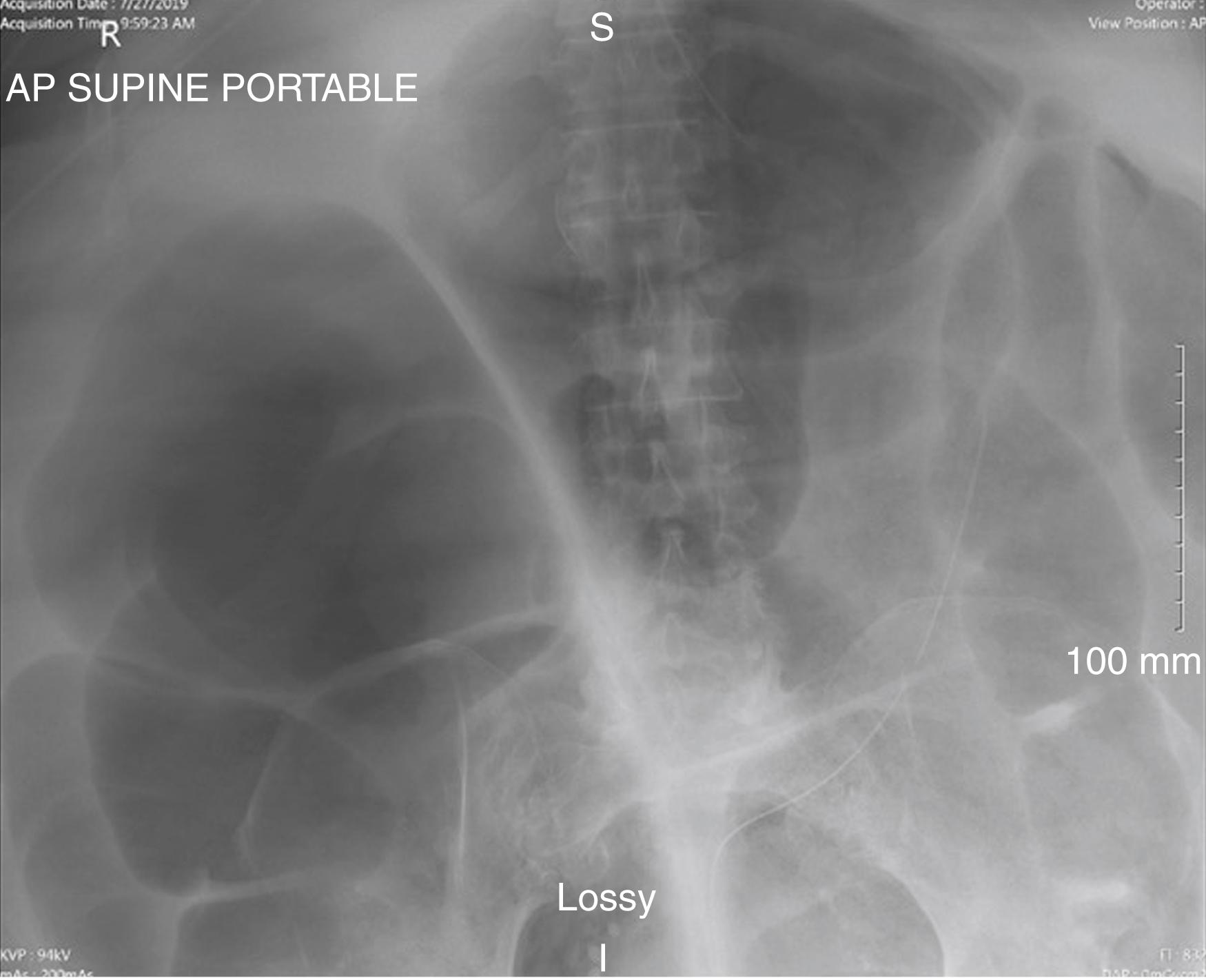

The differential diagnosis includes mechanical obstruction, toxic megacolon due to C. difficile , or toxic megacolon due to other causes.
The treatment of colonic pseudo-obstruction comprises a series of escalating interventions contingent on the degree of distension, risk for perforation, and the patient’s response. Treatment options include supportive care, pharmacologic therapy (neostigmine), endoscopic decompression (colonoscopy), and surgery. Readers are referred to the American Society of Colon & Rectal Surgeons’ Clinical Practice Guidelines.
Nonoperative, supportive care is initiated for patients with a cecal diameter that is less than 12 cm without evidence of ischemia or perforation. This includes nothing by mouth (NPO), correction of electrolyte disturbances, and discontinuation of medications that may be contributing such as opiates, anticholinergics, anti-Parkinson agents, antidepressants, neuroleptics, clonidine, atropines, and antihypertensives. Insertion of a nasogastric tube and rectal tube for decompression may be of help. Osmotic and stimulant laxatives should be avoided as they can worsen colonic dilation. Ambulation, prone positioning, and knee-chest position to encourage passage of flatus can assist. Patients should be monitored with serial physical exams and abdominal x-rays to assess for response or deterioration. Ischemia or perforation of the colon is the most feared complication and has been reported in the range of 3% to 15% of cases, leading to an associated mortality rate of close to 50%. In cases that do not improve with supportive care or with a cecal diameter of more than 12 cm, but without systemic toxicity and abdominal tenderness, colonic decompression is indicated.
Neostigmine is the keystone of pharmacologic decompression therapy. It is an acetylcholinesterase inhibitor that stimulates the muscarinic receptors and enhances colonic motor activity. Neostigmine is given as a 2 to 2.5 mg IV bolus injected over 3 to 5 minutes and results in significant parasympathetic stimulation causing strong colonic peristalsis that usually leads to subsequent flatus and bowel movements. It has been found to be a safe and effective option for patients with acute colonic pseudo-obstruction who have failed conservative management. Success rates for neostigmine treatment range from 60% to 94%, with recurrences observed in up to 31% of patients, with some patients requiring multiple drug administrations. Neostigmine is contraindicated in mechanical bowel obstruction and in patients with signs of ischemia or perforation. It should be used with caution among patients with asthma, chronic obstructive lung disease, bradycardia, and recent acute coronary syndrome and in those with renal failure. Neostigmine should be given in a monitored setting with atropine immediately available. Common side effects include vomiting, crampy abdominal pain, excessive salivation, and bradycardia. Colonoscopic decompression should be considered in patients with contraindications to neostigmine or for those who are unresponsive to it. The aim of endoscopic decompression is to advance the scope to the right colon with minimal insufflation and use of narcotics and place a colonic decompression tube while removing as much gas as possible from the colon. Endoscopic decompression has a high success rate of 61% to 95% for initial decompression and 70% to 90% for sustained decompression. Colonoscopic perforation rates following decompression for pseudo-obstruction are in the range of 1% to 3%.
Patients who do not respond to other lines of treatment or those who demonstrate signs of systemic toxicity, ischemia, or perforation require surgery. Surgical options are determined according to the condition of the colon and the patient. If the colon is viable, tube cecostomy or cecostomy can be performed, with high rates of success. For patients with signs of ischemia or perforation, a resection, usually with a diverting stoma, is recommended.
IBD, which includes both UC and Crohn disease, are largely diseases of the Western world. As Asian countries are adopting a more Western diet, the incidence of these disorders is increasing in these countries as well. The prevalence of IBD in Western countries is approximately 0.5% of the general population. In the United States, over 1 million individuals are estimated to have IBD, with over 200,000 Canadians affected, and 2.5 to 3 million individuals in Europe having these disorders. The highest incidence of UC has been reported in Europe, followed by the United States, whereas for Crohn disease, the highest incidence was observed in the United States, followed by Europe. Europe was noted to have the highest prevalence of IBD. Over time, the incidence of both disorders appears to be increasing. Both disorders appear to have a genetic predisposition with many contributing environmental factors. Over 10% of patients with IBD have a family history of IBD. To date, genome-wide association studies have linked to over 230 IBD susceptibility loci. Cigarette smoking is the most studied environmental factor, having opposite effects in UC and Crohn disease. In UC, smoking tends to suppress symptoms, whereas in Crohn disease, smoking tends to exacerbate symptoms. Antibiotic use in early life has also been thought to predispose to IBD, as has NSAID use.
The extent of UC can also be graded with respect to the extent of inflammation within the colon. It can be limited only to the rectum and sigmoid colon (proctitis or proctosigmoiditis), restricted to the left side of the colon, or extended to involve the entire colon (pancolitis).
There are many classification schemes of Crohn disease. However, one of the most popular was initially the Vienna Classification, which was later updated to the Montreal Classification. With these classification schemes, patients are classified according to age of onset of disease, bowel location of their Crohn disease, as well as type of disease behavior. In addition to the different ages of onset, the Vienna Classification divided patients into whether or not they develop inflammatory Crohn disease at age of 40 or later. The Montreal Classification subdivides this into less than 20 or greater than 20 years old. In addition, the Montreal Classification adds a further subdivision of whether the patients have perianal Crohn disease. The three different types of behavior classifications for Crohn disease that are possible include inflammatory Crohn disease, fibrostenotic Crohn disease, and fistulizing Crohn disease. Many people feel that these three types of disease behaviors represent different time points in the progression of disease. In other words, a patient is initially diagnosed with inflammatory Crohn disease, which over time progresses to fibrostenotic Crohn disease. This, in turn, will frequently progress to an obstruction, with perforation proximal to the obstruction and abscess formation. When this abscess spontaneously drains into an adjacent structure or organ, fistula formation ensues. In this manner, there is a progression from inflammatory to fibrostenosing to fistulizing Crohn disease. It is with this thought in mind that the progression to “top-down” medical therapy has evolved (see later discussion on medical therapy). The goal is to interrupt this natural progression or cycle in the course of Crohn disease to prevent the progressive fibrosis that results in many of the complications leading to surgery.
Clinical presentation of both diseases can be similar. Diarrhea can be a presenting symptom in both diseases; however, this is typically more prevalent and severe in UC, where the diarrhea is characteristically bloody. Significant hemorrhage is much more common with UC than with Crohn disease. Typical UC symptoms also include tenesmus and urgency as well as associated anemia. In Crohn disease, symptoms of abdominal pain may predominate. In any patient initially presenting with diarrhea, stool cultures should first be obtained to exclude the presence of infectious causes of diarrhea, such as Salmonella , Giardia , or community-acquired C. difficile that is now increasingly seen. Patients with Crohn disease may present with a palpable abdominal mass due to an intraabdominal abscess or have an external fistula. Roughly 25% of patients with Crohn disease will have associated perianal disease. This can include a variety of problems, including anal fissure, which in contrast to patients without Crohn, is often not painful and may be multiple. In addition, these patients can present with large anal skin tags ( Fig. 52.30 ), which are not true external hemorrhoids. As a rule, these should not be excised, as they may lead to very delayed wound healing. These patients may also present with anorectal abscesses, fistula(s) ( Fig. 52.31 ), and anal stenosis. Digital rectal examination should always be performed.
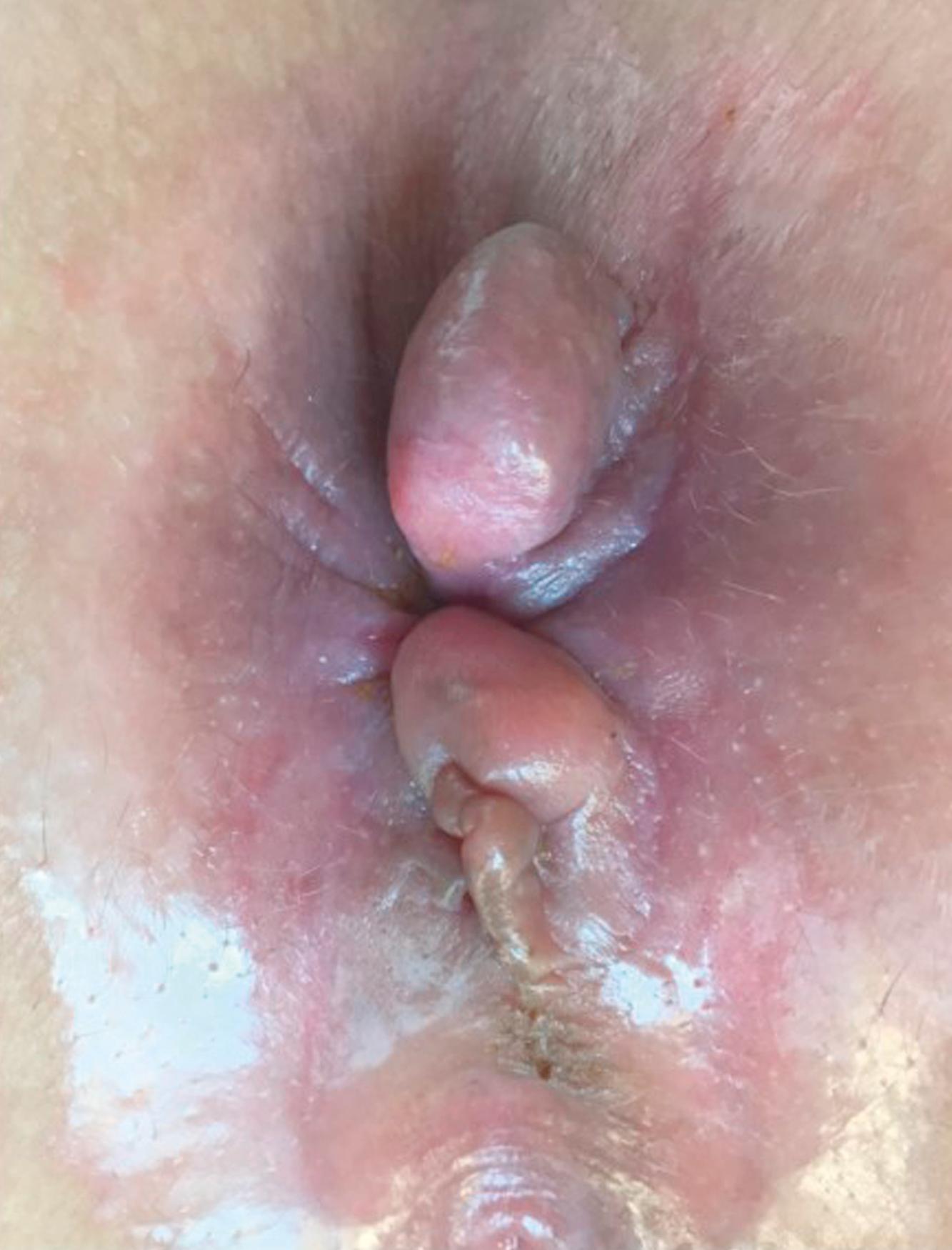
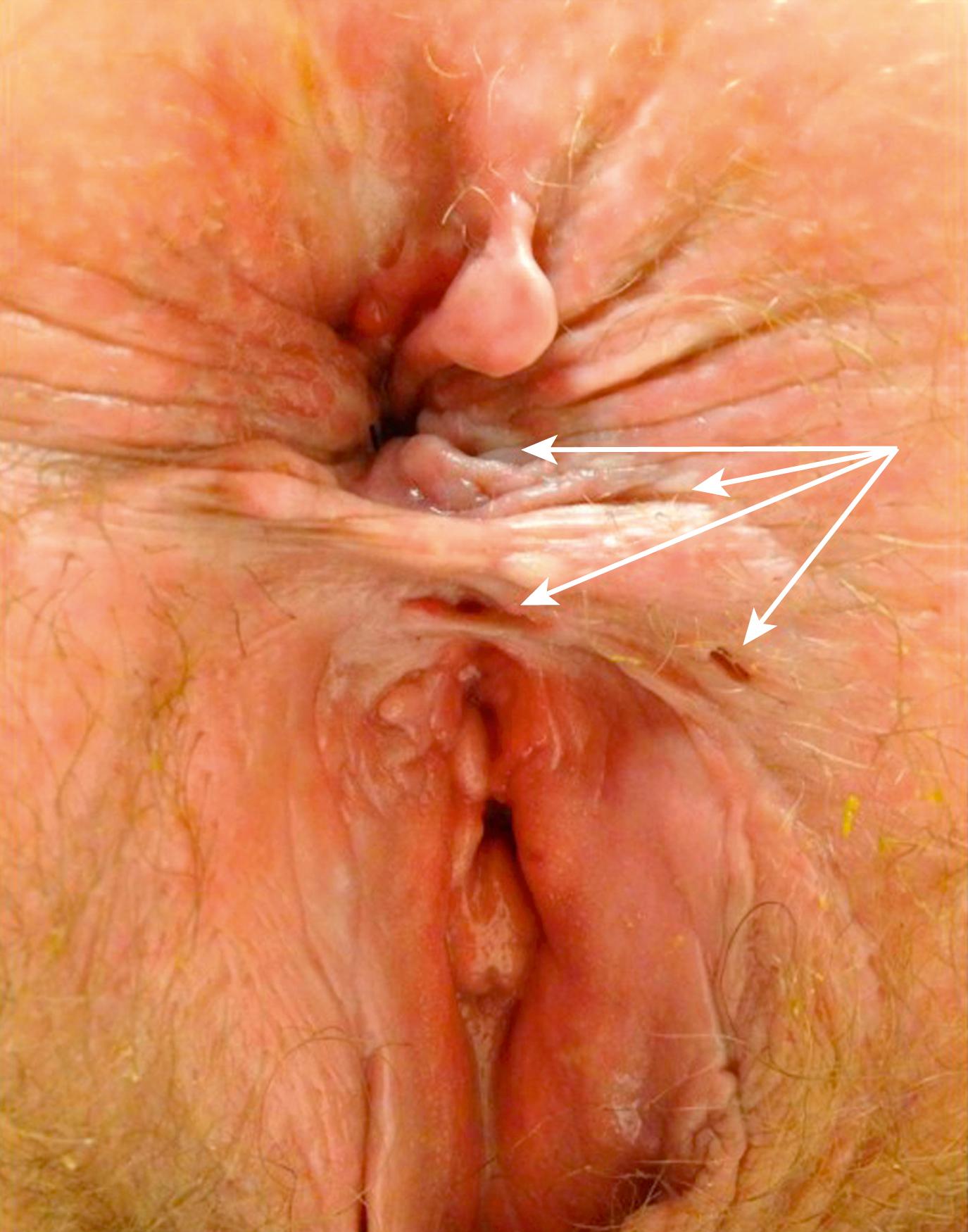
Extraintestinal manifestations can occur in many IBD patients, and it is estimated that up to half of IBD patients will have one or more extraintestinal manifestations. There is a slightly higher prevalence of extraintestinal manifestations in patients with Crohn disease as compared with those with UC and can be divided into those affecting the joints, eyes, and skin. Arthritis is by far the most common extraintestinal manifestation. One of the most common manifestations is sacroiliitis. One of the most serious joint manifestations is ankylosing spondylitis which runs a course independent of the bowel disease. These patients are HLA-B27 positive and may present in advanced cases with decreased cervical flexion, which has important anesthetic implications for intubation. These patients may require fiber optic intubation and will require specific preoperative anesthesia evaluation.
Cutaneous extraintestinal manifestations include erythema nodosum and pyoderma gangrenosum. From long experience of treating surgical patients with IBD, pyoderma is much more frequent than erythema nodosum. Erythema nodosum ( Fig. 52.32 ) is characterized by red painful swollen nodules that can occur and usually will respond to systemic steroid administration, whereas pyoderma gangrenosum is characterized by typically extremely painful ulcerating lesions that frequently occur at sites of repeated trauma such as in the vicinity of surgical incisions or more frequently around intestinal stomas ( Fig. 52.33 ). There is a phenomenon called “pathergy,” which refers to a worsening of the pyoderma with any type of surgical manipulation or debridement. These lesions are therefore best treated by nonoperative means and can include intralesional steroid injections (i.e., triamcinalone), topical (tacrolimus 0.1%), or systemic biologic therapy (anti-tumor necrosis factor [TNF] antibodies or similar agents). Such treatment will typically result in symptom resolution.
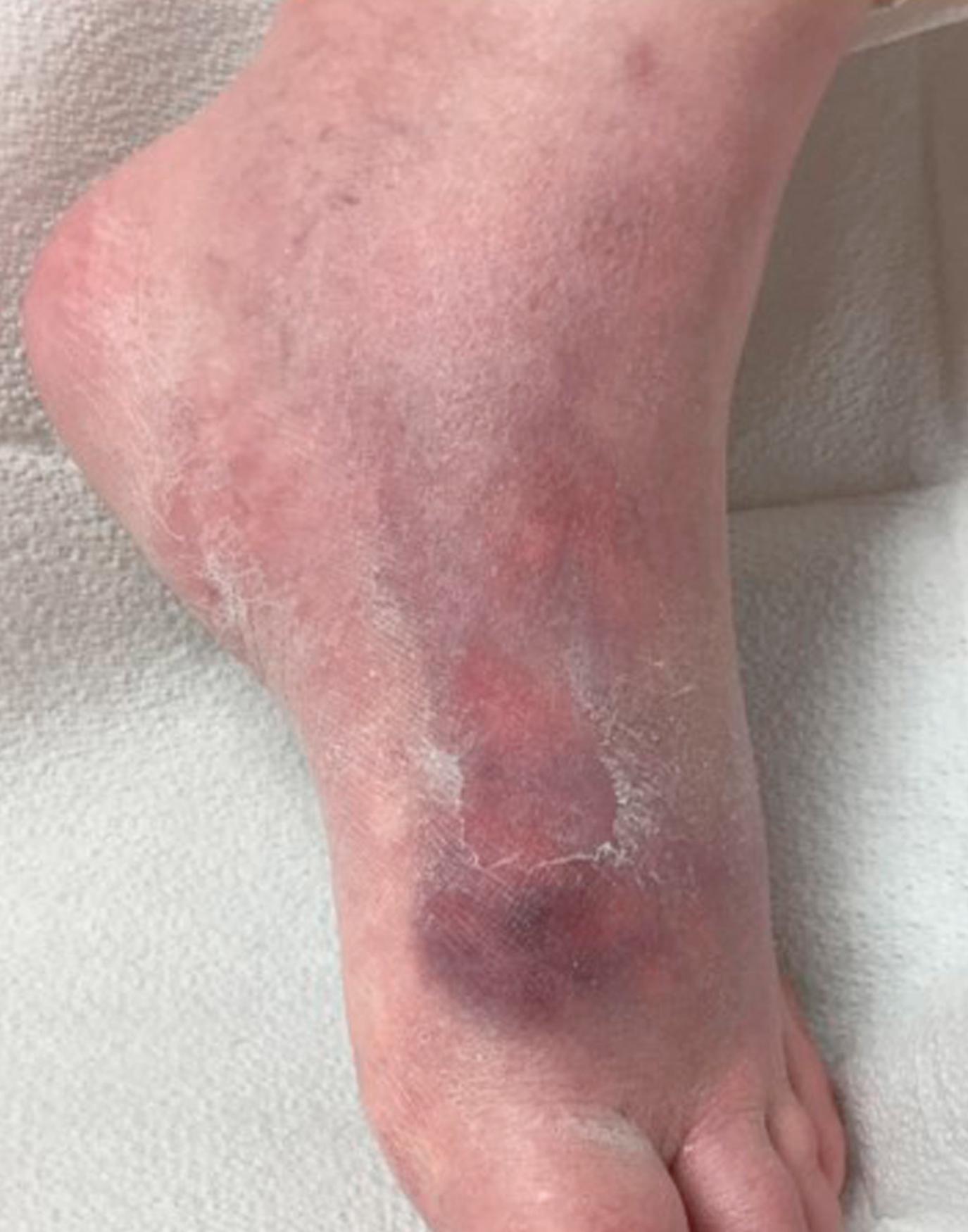
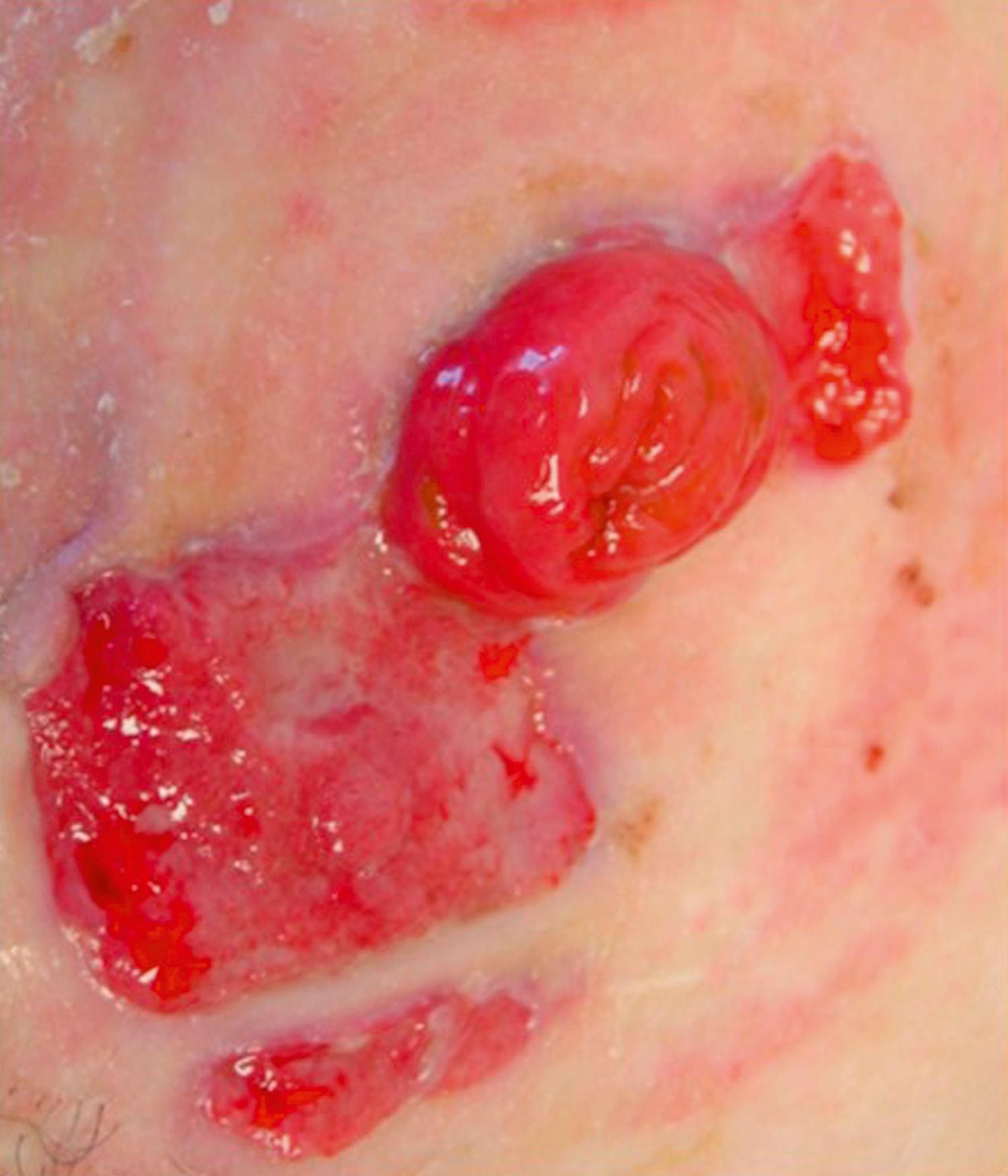
Ocular manifestations of UC can include uveitis, iritis, and episcleritis. Some of these can lead to significant irritation and require referral to an ophthalmologist.
Sclerosing cholangitis is estimated to affect approximately 5% of patients with IBD. It has a course that is curiously independent of the IBD. At its worst, it can progress to cirrhosis, result in liver failure, and require hepatic transplantation. Patients with sclerosing cholangitis are at higher risk for developing colorectal neoplasia, as will be discussed later, and are also at higher risk of developing pouchitis, as will be discussed in the section on IPAA and surgical treatment.
Become a Clinical Tree membership for Full access and enjoy Unlimited articles
If you are a member. Log in here